Being in La Grande Motte in the French Camargue to attend the Multihull Boat Show of 2023, I of course look for cool boats and new things to write about. My personal highlight of this boat show and therefor the first article to be published about this year´s La Grande Motte edition, was the sea trial of the Outremer 45 sailing catamaran: Honestly, a very exciting and above all instructive lesson on catamaran sailing and performance.
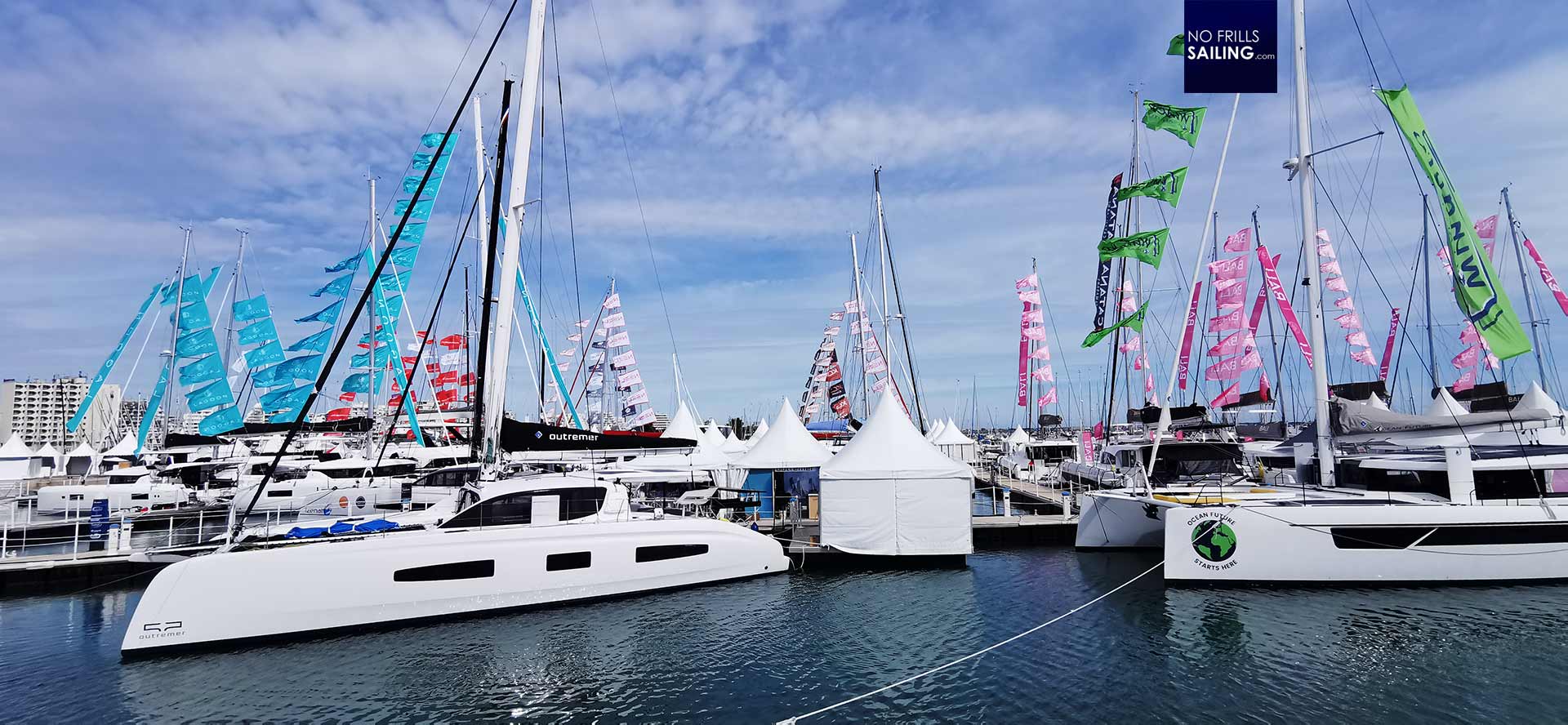
The Outremer 45 is a true classic and one of the bestselling catamarans by the French shipyard which has their headquarter right vis-à-vis the boat show venue right here on La Grande Motte. By this, it was no wonder that Outremer has a full display of the whole range of their products. It is not been since the media boost generated by LA VAGABONDE that the Outremer 45 is the dreamyacht for many (I shall say “generations”) of sailors. She is truly a classic, constantly updated by the yard.
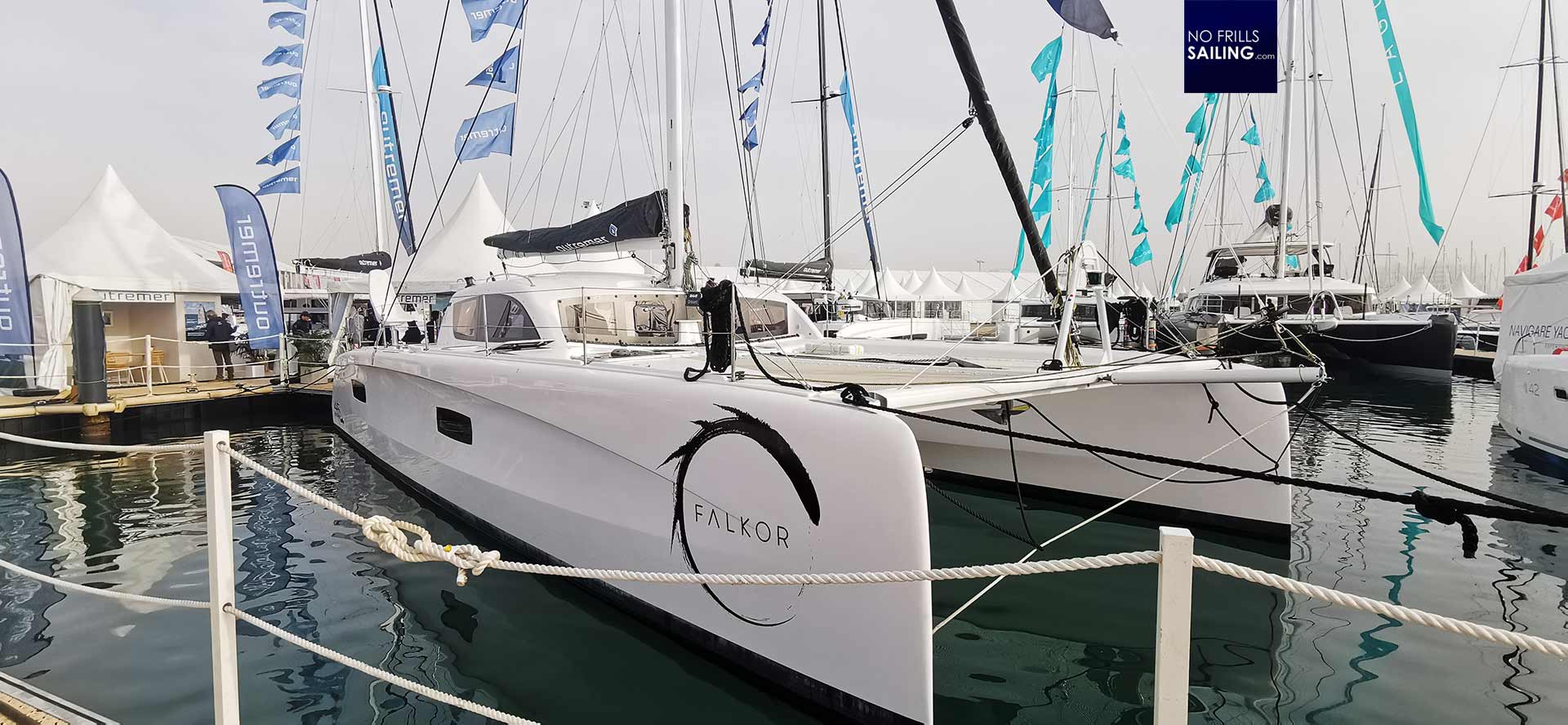
This blue water ocean cruising catamaran is a designated long haul boat made for mile-eating and the circumnavigation. At 14.63 meters in length she is just 7.15 meters wide: A first hint oh her capabilities. With 106 square meters of upwind sail area and a weight of just between 9 to 11 tons, she can be rightfully considered as a powerful and lightweight multihull. I am very grateful and happy that the shipyard – as the only brand attending the boat show – provided two cats for sea trials for the general public: The Outremer 45 and a brand new 55.
Very strong breeze: Outremer goes out!
This year we have been lucky with the weather: No rain at least so far, as everyone concluded. But wind we´ve had plenty. With constantly between 18 and 22 knots in the marina, gusts powering up to 34 knots (!) an ice-cold breeze was coming in from the East. Nevertheless, Outremer kept on providing the sea trials. When I went to the departure pontoon, the boat just came in from a previous sea trial. A picture-book perfect example of professional boat handling!

The skipper had toc pe with sheer winds and really violent gusts. The light weight of the catamaran made him powering up the engines almost all the time at full throttle to prevent her from being pushed off course. The parking slot was terribly narrow: The stony breakwater just 3-4 meters away from the outside hull and literally one meter to either side of the boat, it was pure joy and excitement to witness this master class in boat handling. Chapeau, Captain, I shouted as he landed her safely without hitting any pillar or the pontoon: Wow!
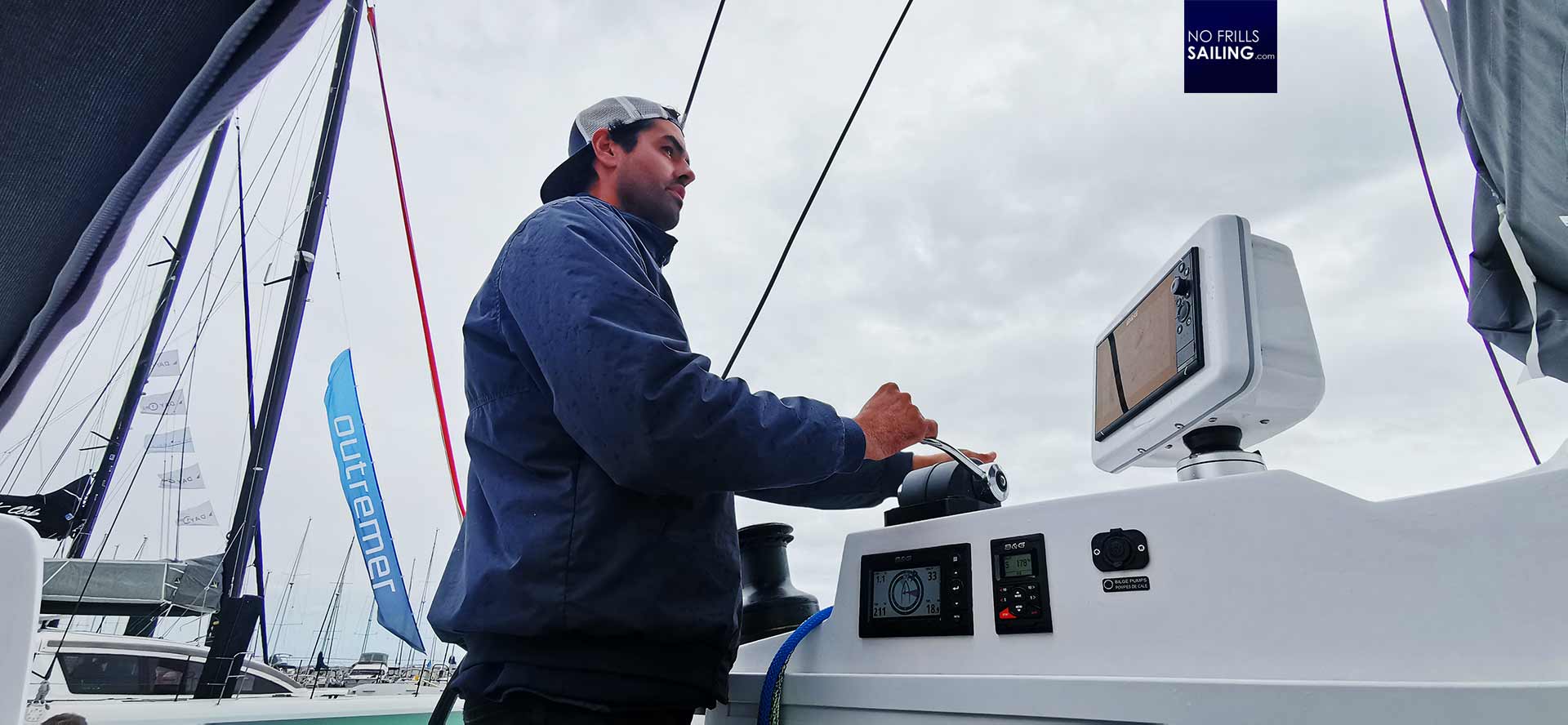
Out Captain works as full time skipper for Outremer, he told me. In this he of course is well trained and safe handling the boat even in these violent conditions. Remembering my own efforts maneuvering my catamarans during the handover and delivery trips, I was paralyzed in awe and stood in admiration for this kind of excellence. Well, handling a catamaran in the marina, especially such a lightweight specimen, calls for crew excellence and absolute control.
Boarding the Outremer 45: Inspecting its wings
We had been a party of six persons on this trip: A family with a teenager and a sailing couple. The family stated they are first buyers with virtually no cat-experience, just looking for a fast cruising cat. The couple, as they told me, were experienced catamaran skippers coming from multiple years and thousands of miles experience on an older Fontaine Pajot Bahia, looking for more speed and fun. The guests could not have been more different, I shall say.
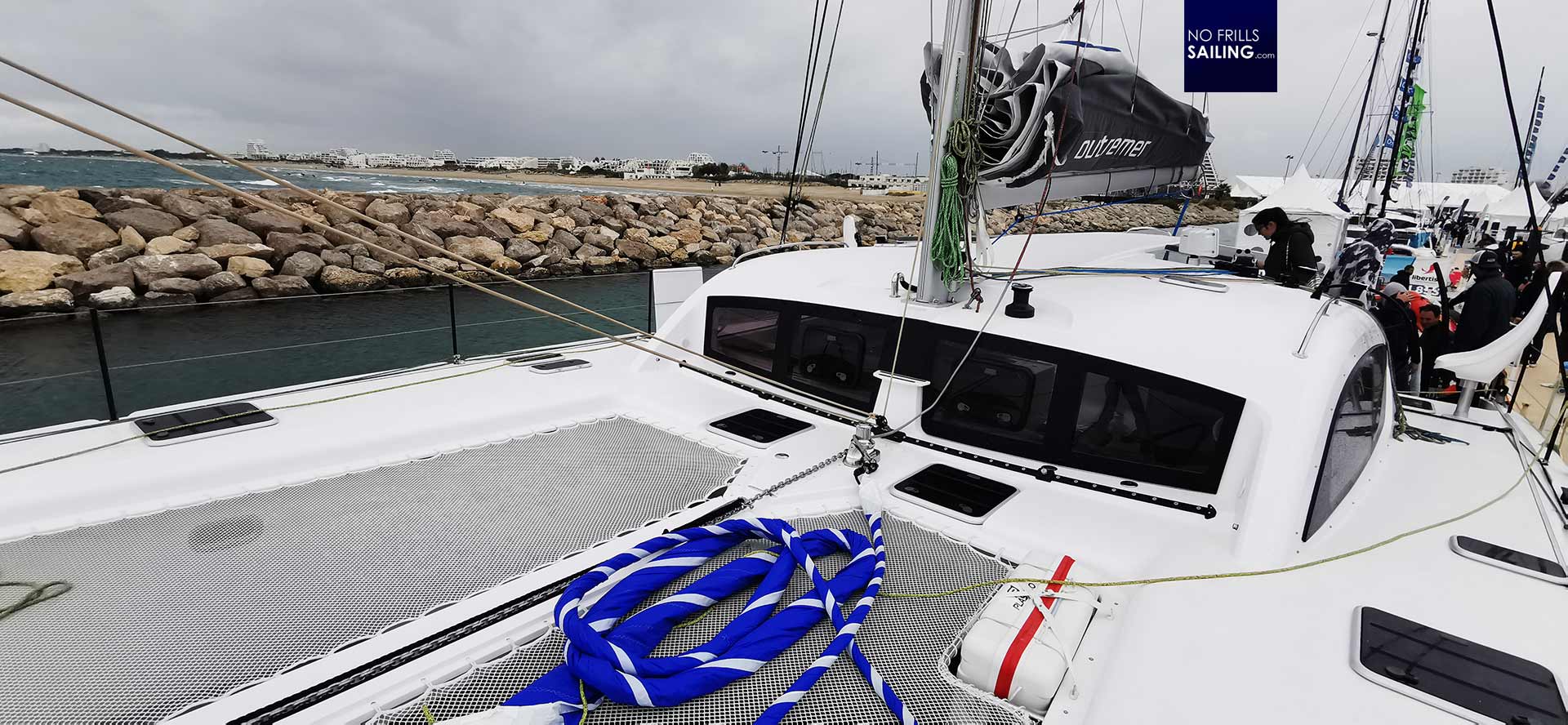
Before casting off again, I took the chance to walk around the Outremer 45. At 44 feet she indeed is a big boat, no question that she is made for the long trip, the open seas and all kinds of weather conditions (which we would experience just a few minutes later). I felt safe but I must say that the Outremer is slimmer and much “racier” than the dedicated cruising catamarans. Compared to our own brand, the Excess, this boat clearly was clearly made for much more “serious” sailing families or crews.
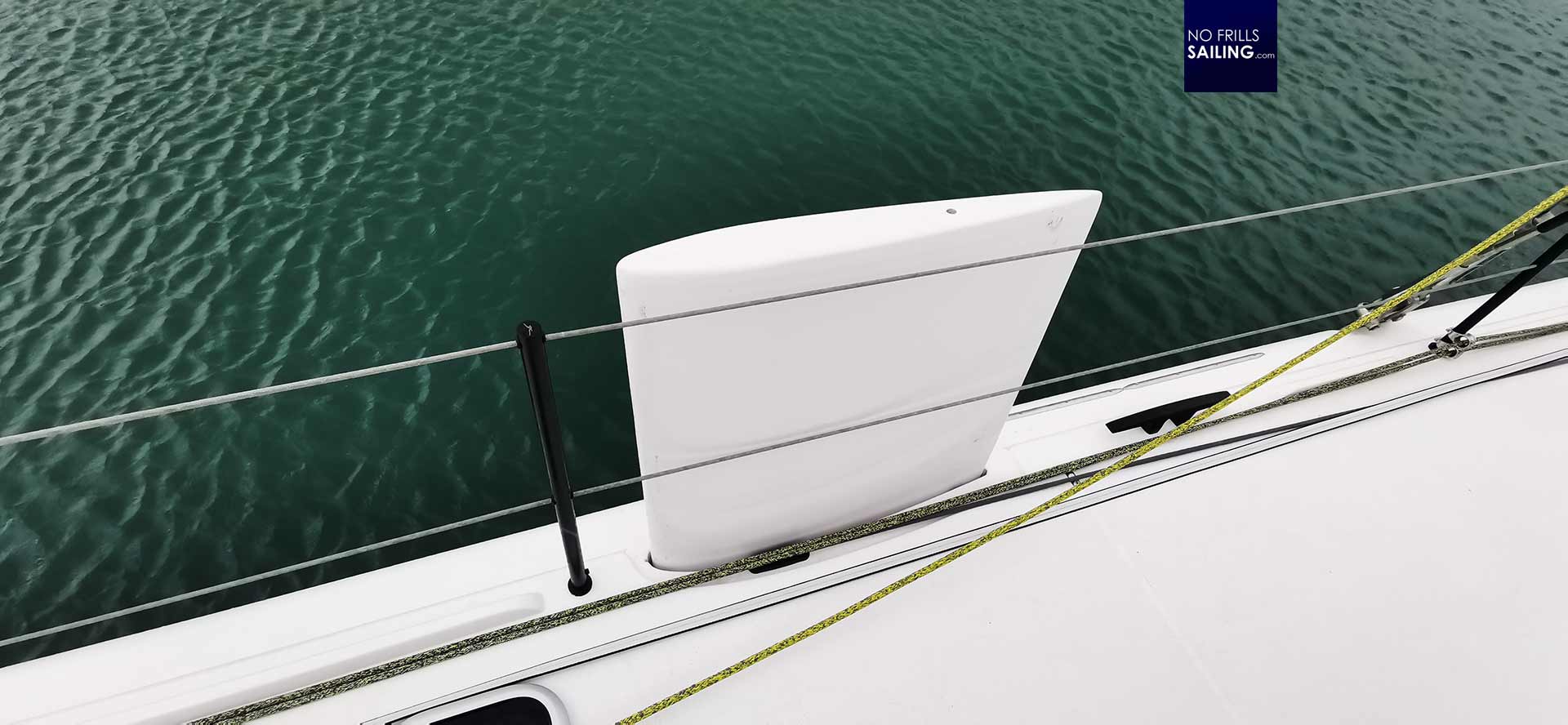
This fact is underlined by the presence of daggerboards in the Outremer 45. This is a deciding feature of this class of catamarans. Taken out mainly on upwind courses these deep daggerboards will provide longitudinal stability and act like the keel in a monohull: Keep the boat on her due course and prevent too much leeway. In this, the Outremer 45 is more pointy and powerful on these points of sail, clearly an advantage over classic cruising cats with their fixed and often small fins.
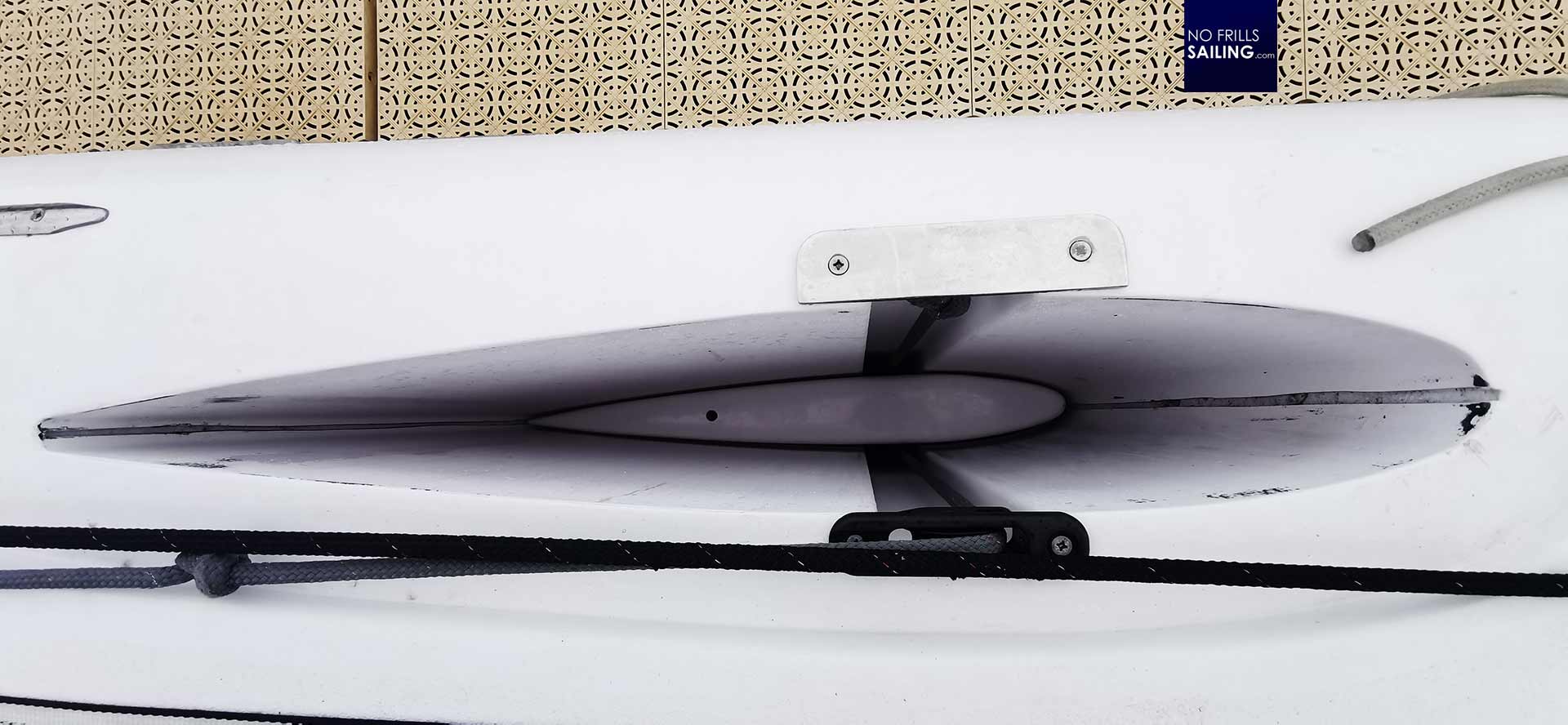
On the Outremer 45 the daggerboards are lowered by easing a daggerboard halyard which is running all back to the cockpit. As it is a straight “wing” gravity will make it go down when the clamp is opened and the halyard is eased. There are two winches in the cockpit´s aft over which the daggerboards can be taken up again – depending on the point of sail and the speed of the boat, the sailor can lower them stageless, which our Captain explained later to me.
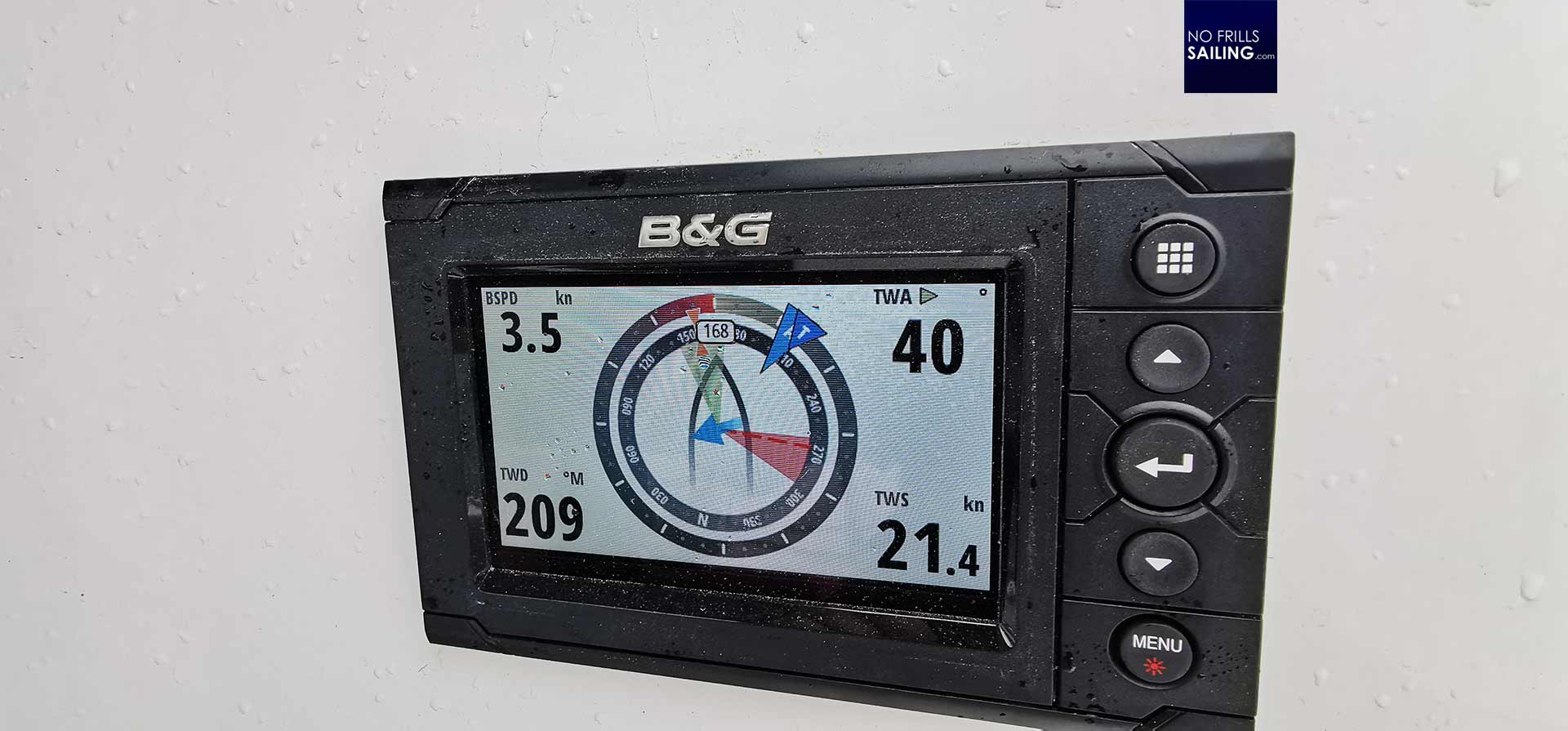
Of course, we were lucky, and a rain shower set in upon casting off. Since I was prepared for spring temperatures I did not had any sailing gear at hand and so I retreated under the solid bimini. 22 knots within the marina, I observed the calm but determined actions of our skipper who masterfully brought our brand new boat away from the pontoon and out of the marina.
Sails up! Operating the Outremer 45
The boat started to move up and down upon leaving the marina. Having a constant easterly wind – is this the famous Mistral, by the way? – her motions became instantly violent. Moms and the one sone went into the saloon to be protected from the wind and the rain that increased ever so slightly. The Captain and his aide went into the waves and started to hoist the main sail.
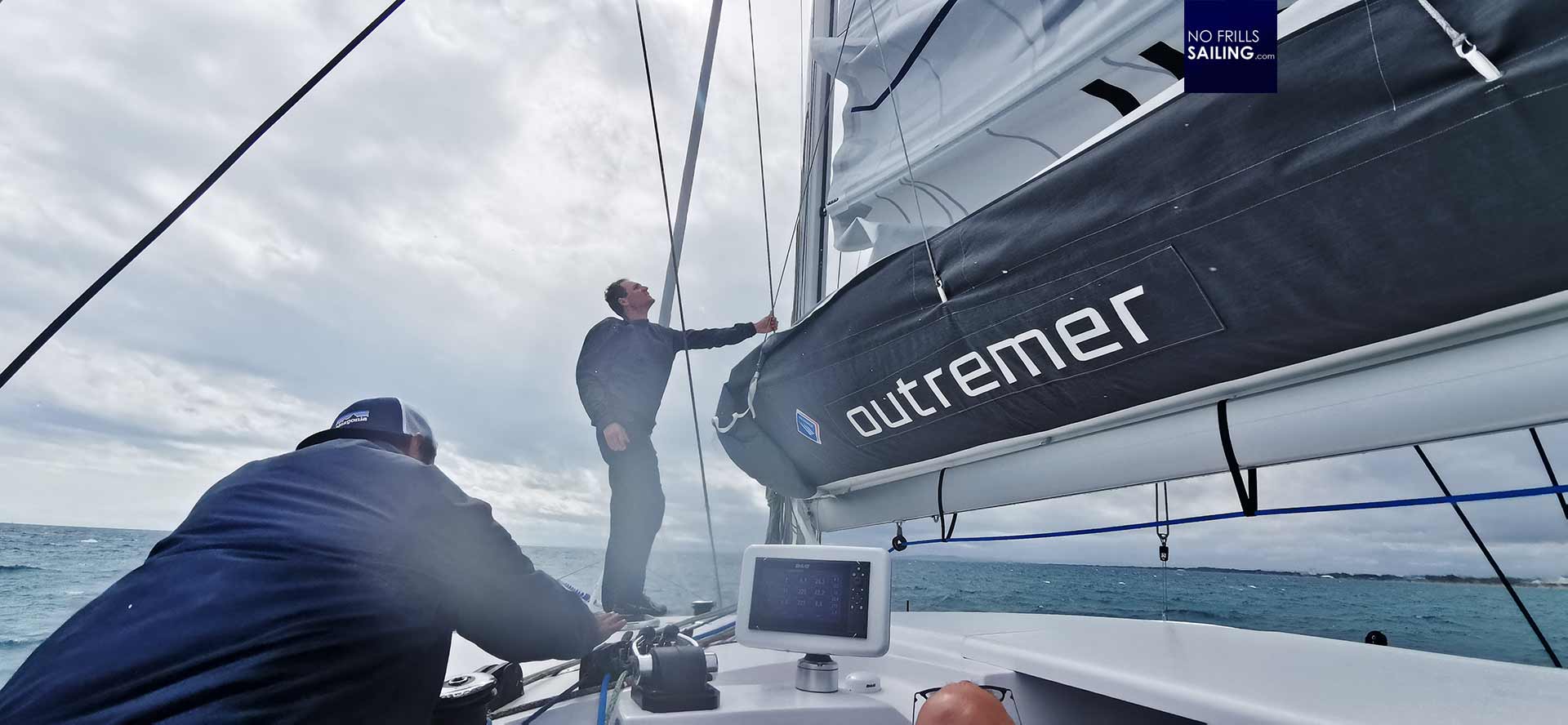
Somehow the aide went out to the mast foot. I did not really understand why as I suppose that the reefing system in the Outremer 45 is a one-line-system as well so that there should not be the need to have a man at the mast, I guess it was just for observing and keeping the sail´s head from getting entangled with the lazy jacks.

This was a good chance to inspect the Skipper´s workplace. The Outremer 45 is steered from a central steering post on the starboard side. It is not a full flybridge yet not a helmsman-position “inside”, a mix of both, I shall say. From up here the helmsman has a great view of the boat, especially the port side. Berthing her alongside to starboard may be tricky, her chocolate side is to her left. Nearly all lines to operate the sails are diverted to two working winches on the roof. Halyards, sheets and reefing lines. There is a big 12 inch-plotter and some secondary displays for example for the autopilot well within sight.
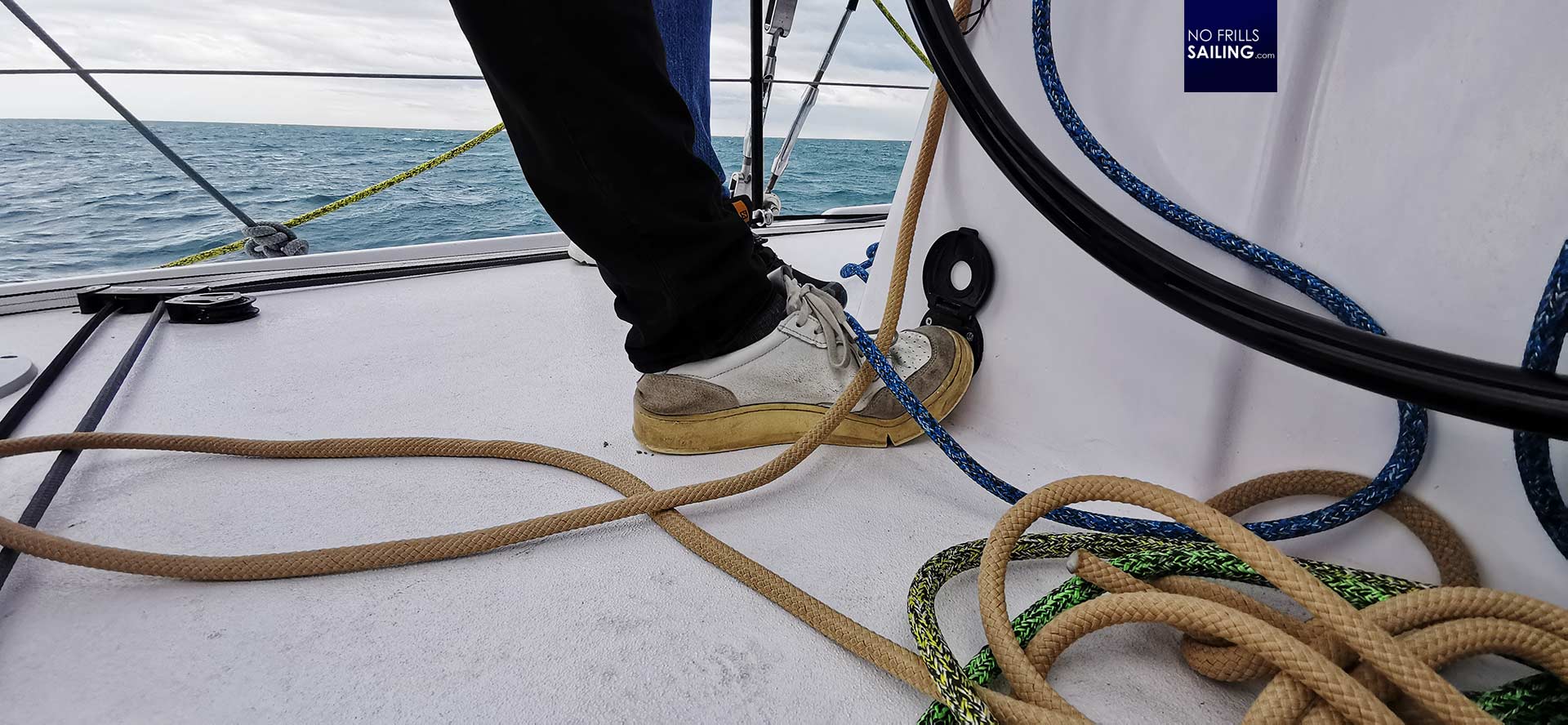
A nice feature of the Outremer 45 and clearly something that enhances her handling is the foot-button over which the electric winches are operated. In this, all two hands are free to handle the ropes. Another sign that this catamaran is made for sailors. We´he had the sails up and in the wind quickly, sheeting in the canvas the catamaran sprung to life.
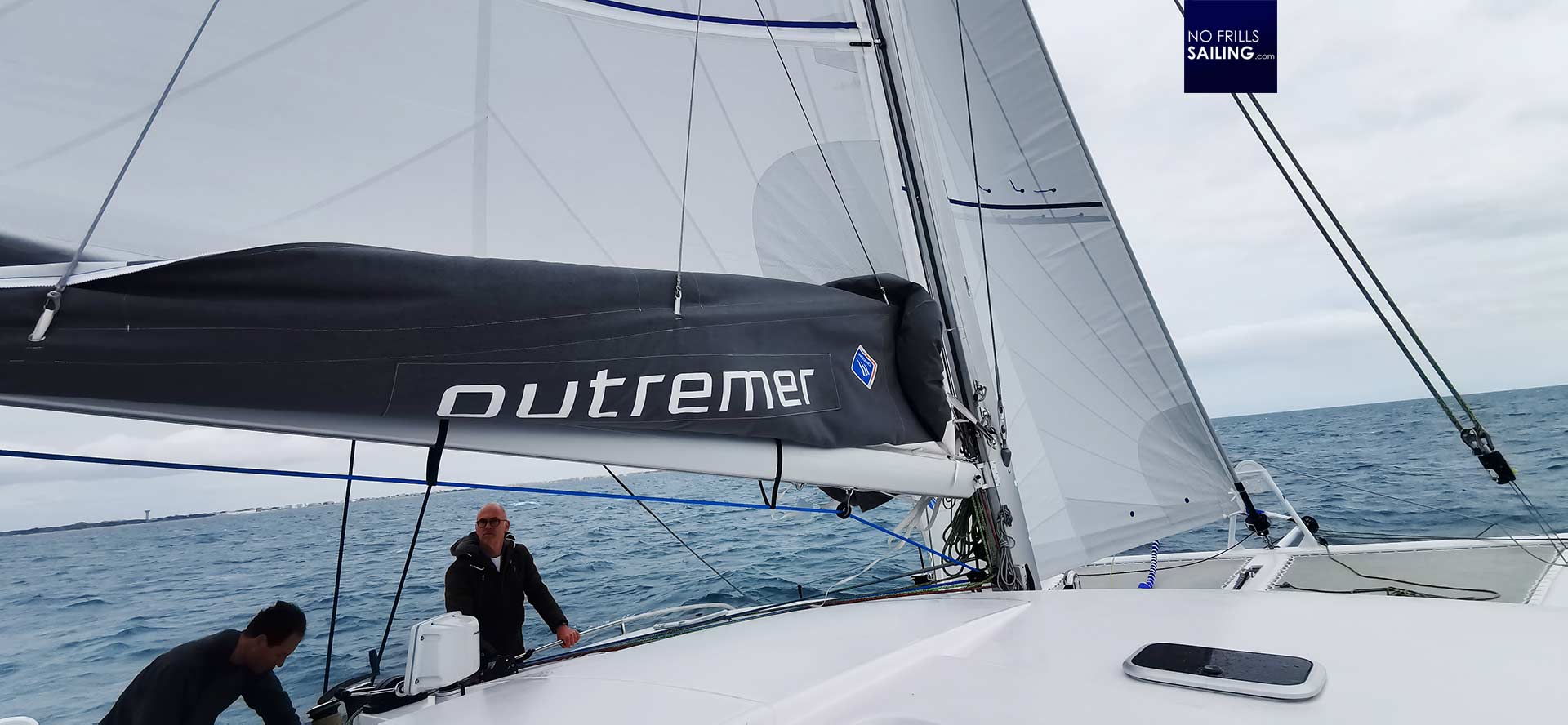
The acceleration was impressive: The boat sped up from 3 knots to two-digit SOG in mere seconds. Our skipper had lowered the leeward daggerboard and handed over the wheel to us so that we might get an impression of how it feels to sail an Outremer. With waves of 1 to 1.5 meters it was quite a bumpy ride – and this was among the most interesting parts of the whole sea trial.
Impressive upwind sailing performance by the Outremer 45
The catamaran mastered the waves exceptionally, I shall say. No slamming at all, no pumping in the mast or the rigging. Even if we would hit a wave head on, being decelerated a bit, the boat immediately catched up to full speed within a short time. We sailed her upwind at around 40 degrees. She can point higher but will loose too much speed with increased stress in the rigging, so there was no point. In this, we sailed out to make some leeway.
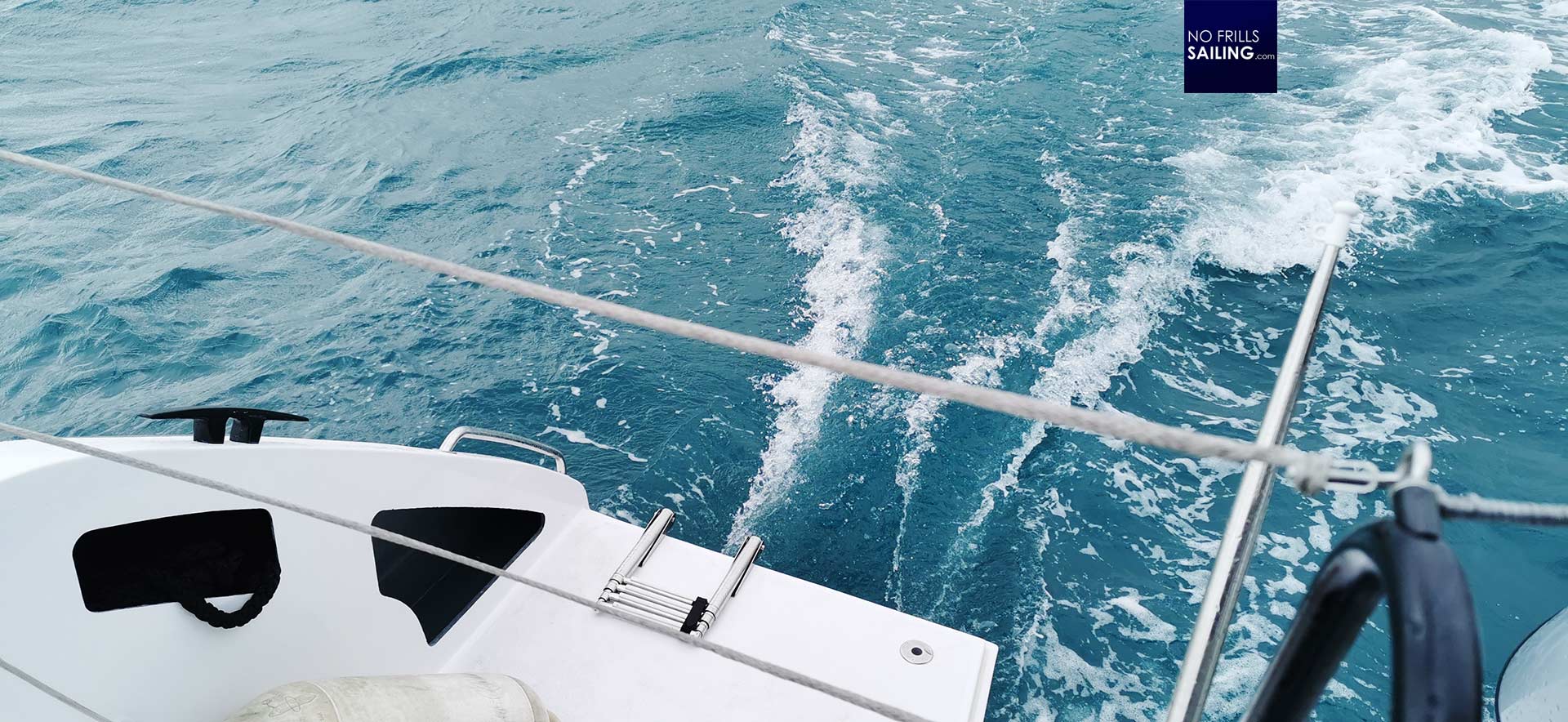
Tacking an Outremer 45 is especially easy since she was equipped with a self-tacking jib. We´ve had her mainsail close hauled and tacked a number of times. I had the feeling that – like with any other boat too – the Outremer 45 at this particular day liked sailing on port tack more than starboard tack, so engaging this maneuver from starboard to port side tack almost brought the boat to a complete halt going through the wind, just to have her speeding up at an impressive rate of acceleration again when through. Wow.
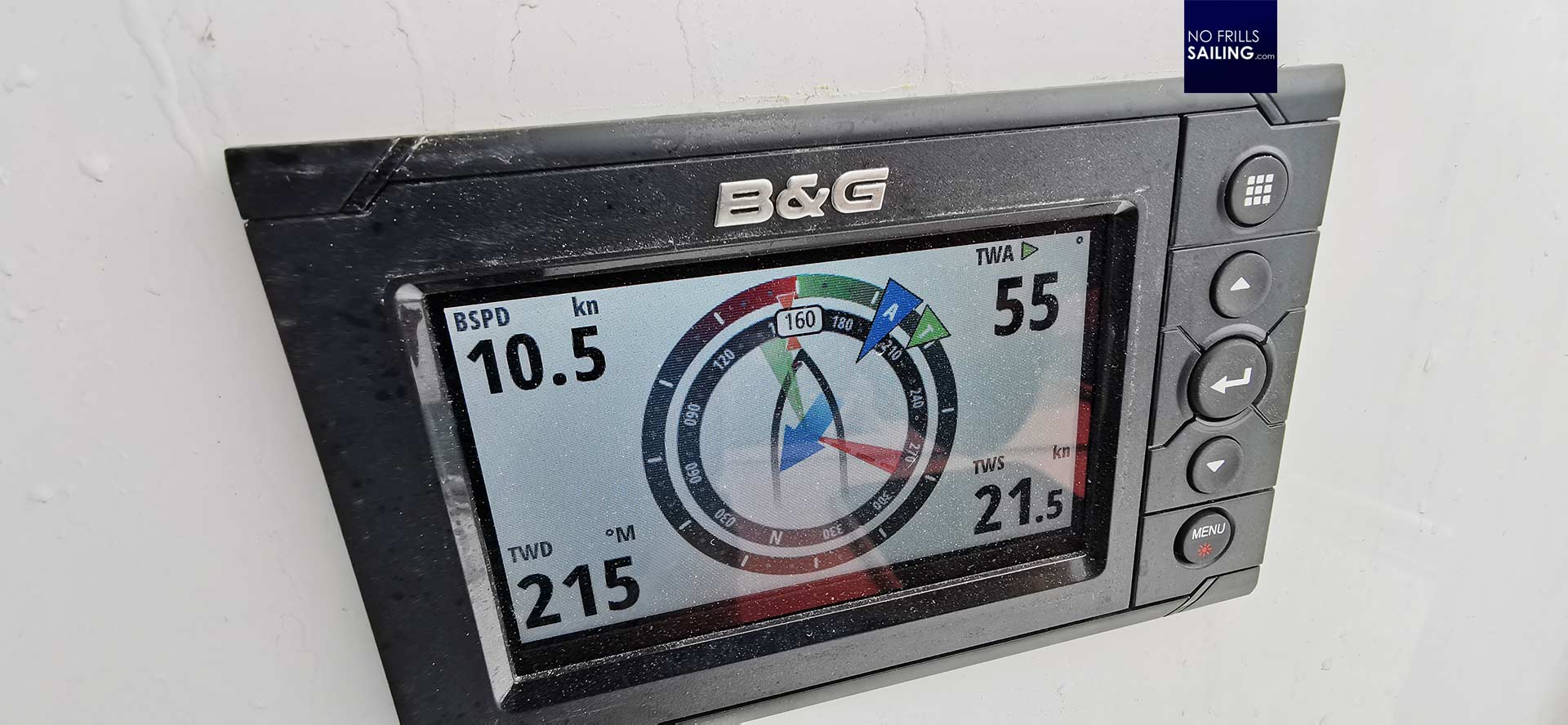
We´ve had 22 to 20 knots true and the boat always transformed 50 to 60 percent of the windspeed into speed over ground. Two-digit sailing upwind was no problem. When we had the luck to sail through two or three smaller waves before getting hit by another big smasher, the boat managed to scratch 12 knots SOG. Upwind!
Calming down, looking around
As the boys took helm above and tried the boat, I took the time to inspect her cockpit and layout a bit more in depth. Of course, as rain was coming down and the icy-cold wind was clearly something we didn´t appreciated, nobody dared to take a seat in the tiller-seats on the aft section of the Outremer. These are a kind of signature of the Outremer and a picture like this might instill this longing for a lush, warm Pacific Ocean sundowner …
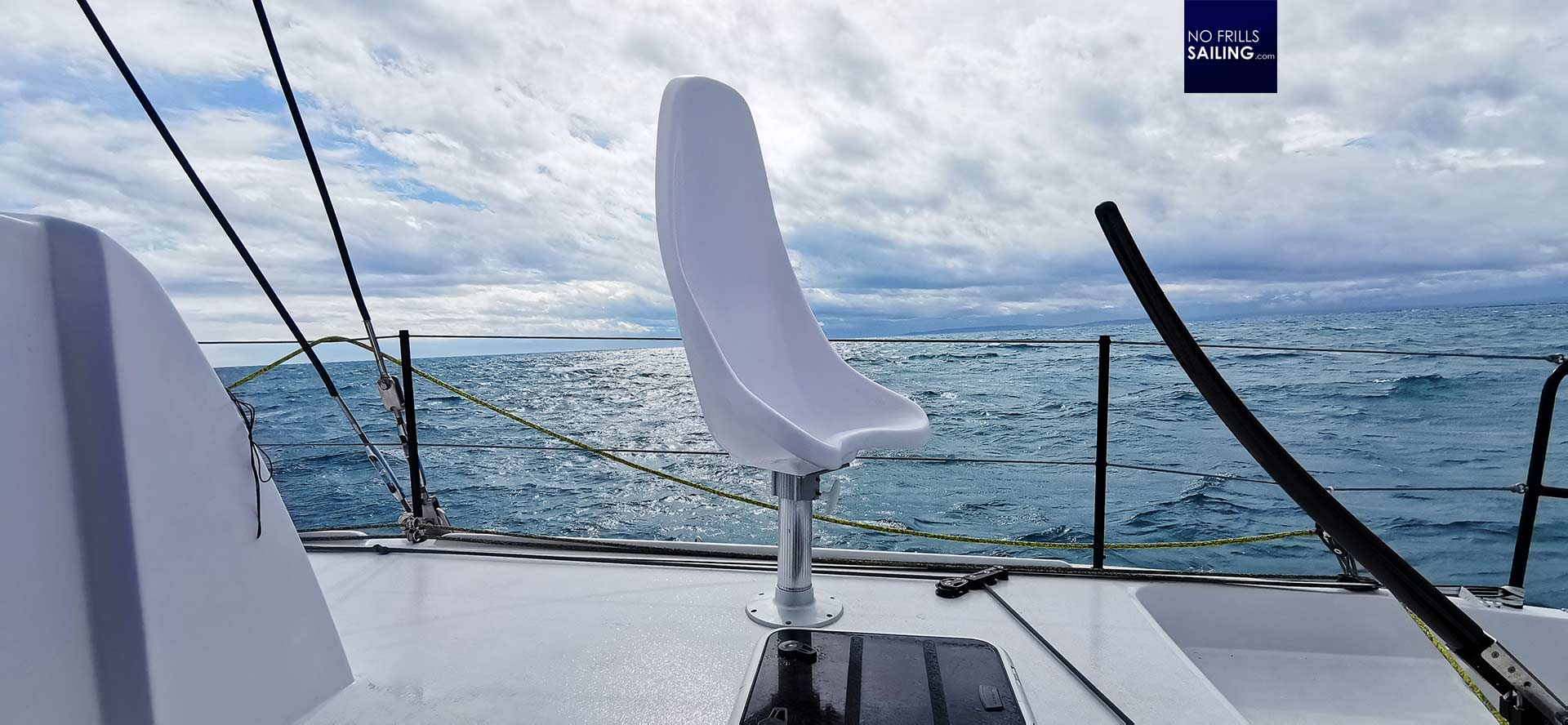
The Outremer 45, I mentioned it before, is clearly a boat made for serious sailors seeking serious sailing sensations. She was not conceived to be pretty or complaisant: Everything aboard is subdued to the idea of providing a performance oriented sailing platform. One sign of this is the layout of the winches and the running rigging.
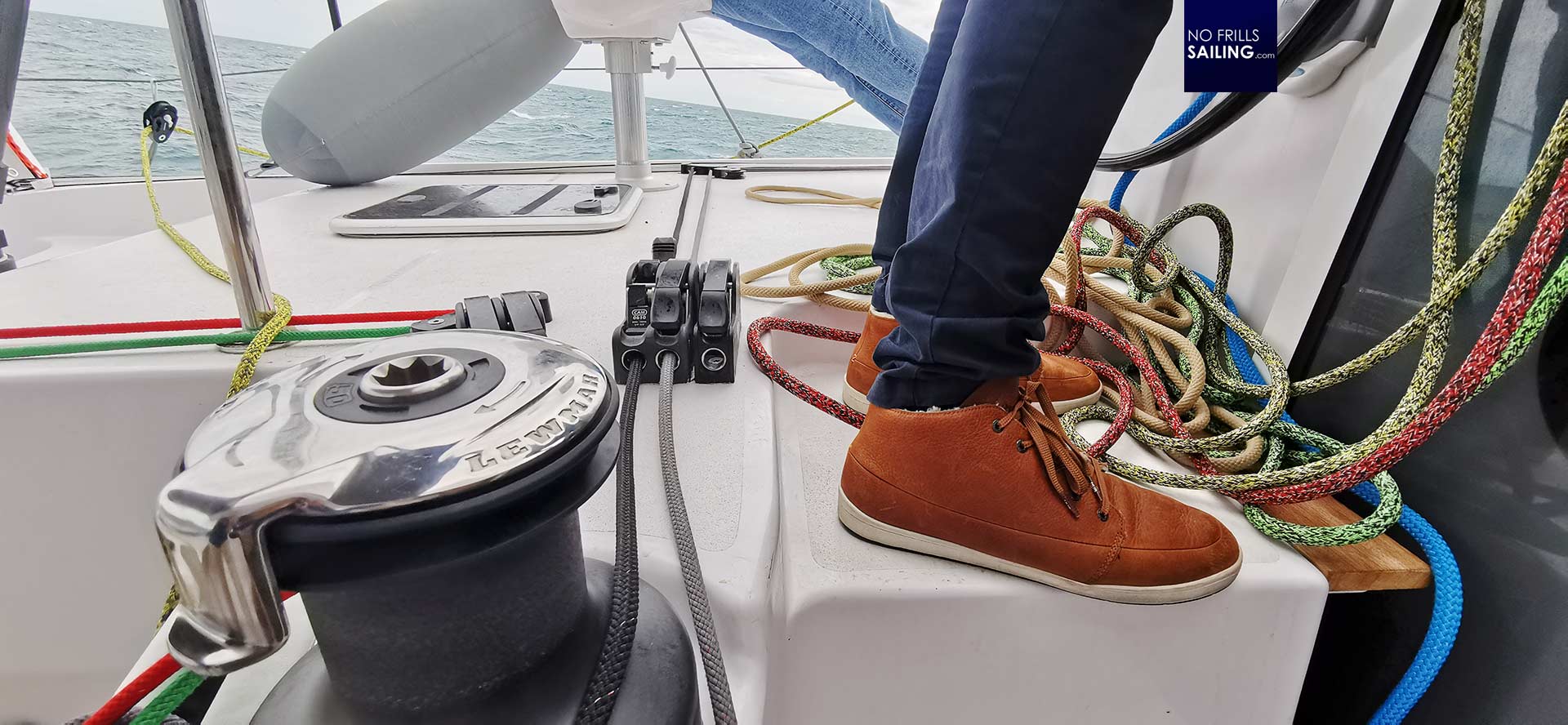
Whereas on dedicated cruising catamarans and even monohulls the designers try to have all lines and trimming accessories diverted in a way that the helmsman or skipper can control the whole boat and trim all sails from one single place, this is different on the Outremer. Up at the helm station the sails are operated, but the cat has two more winches down in cockpit.
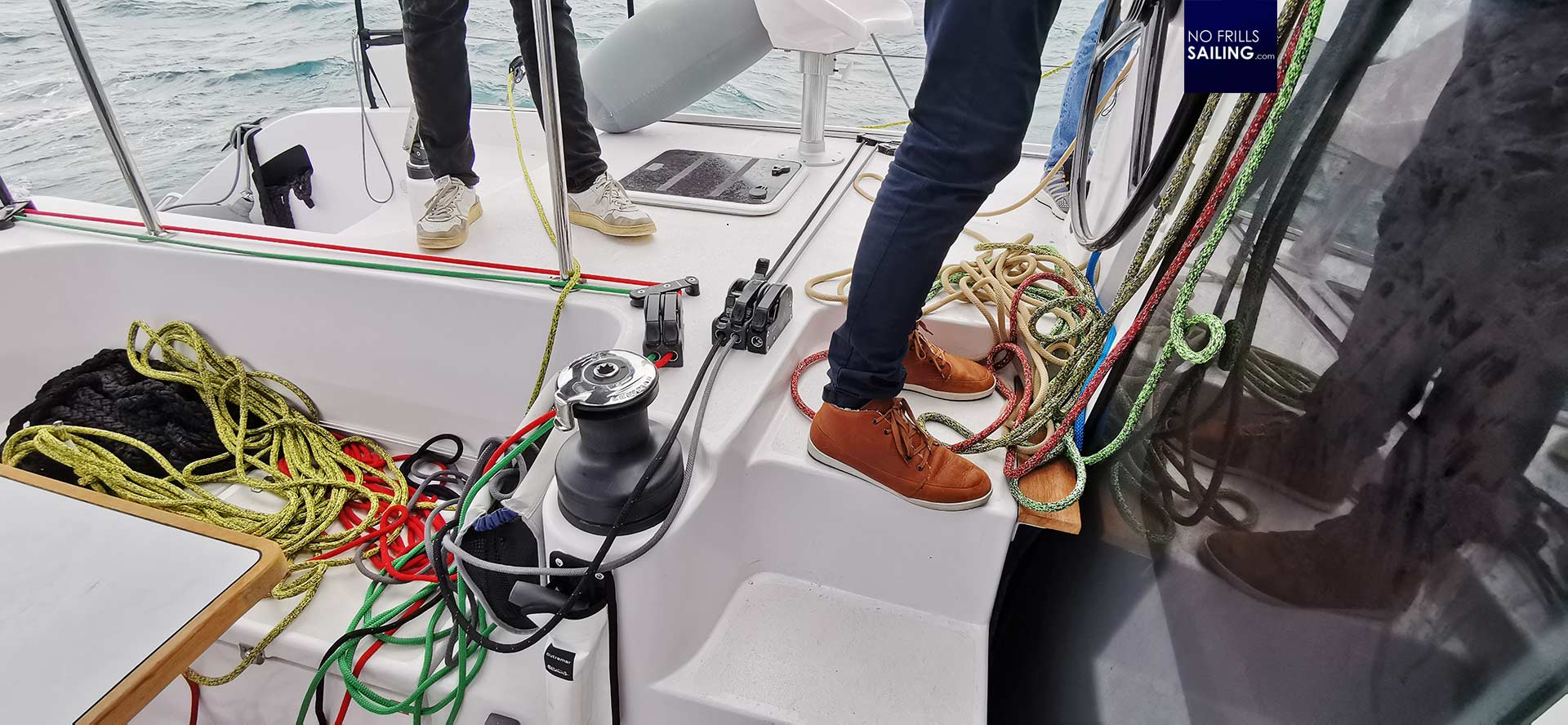
One dedicated winch to port side to operate the mainsheet traveler and the portside daggerboard, one another for the starboard daggerboard. For lightwind sails, meaning Gennaker and Code-sails, both winches are used to operate the sheets. Facing this fact, it is clear that the whole cockpit was filled with a big sheet mumble, lines laying around virtually everywhere: This would not be acceptable in a dedicated cruising or vacation-oriented boat.
Speeding away: A true mile-eater
We left the vicinity of the unmistakable waterfront of La Grande Motte – which by the way always reminds me of a movie set taken from 60ies James Bond or Fantomas movies – and sailed out into the Mediterranean. I tried to imagine the feeling that a real owner-crew of this catamaran might have at this moment: Just leaving the dockside to start a journey of a lifetime. What a great feeling this must be.
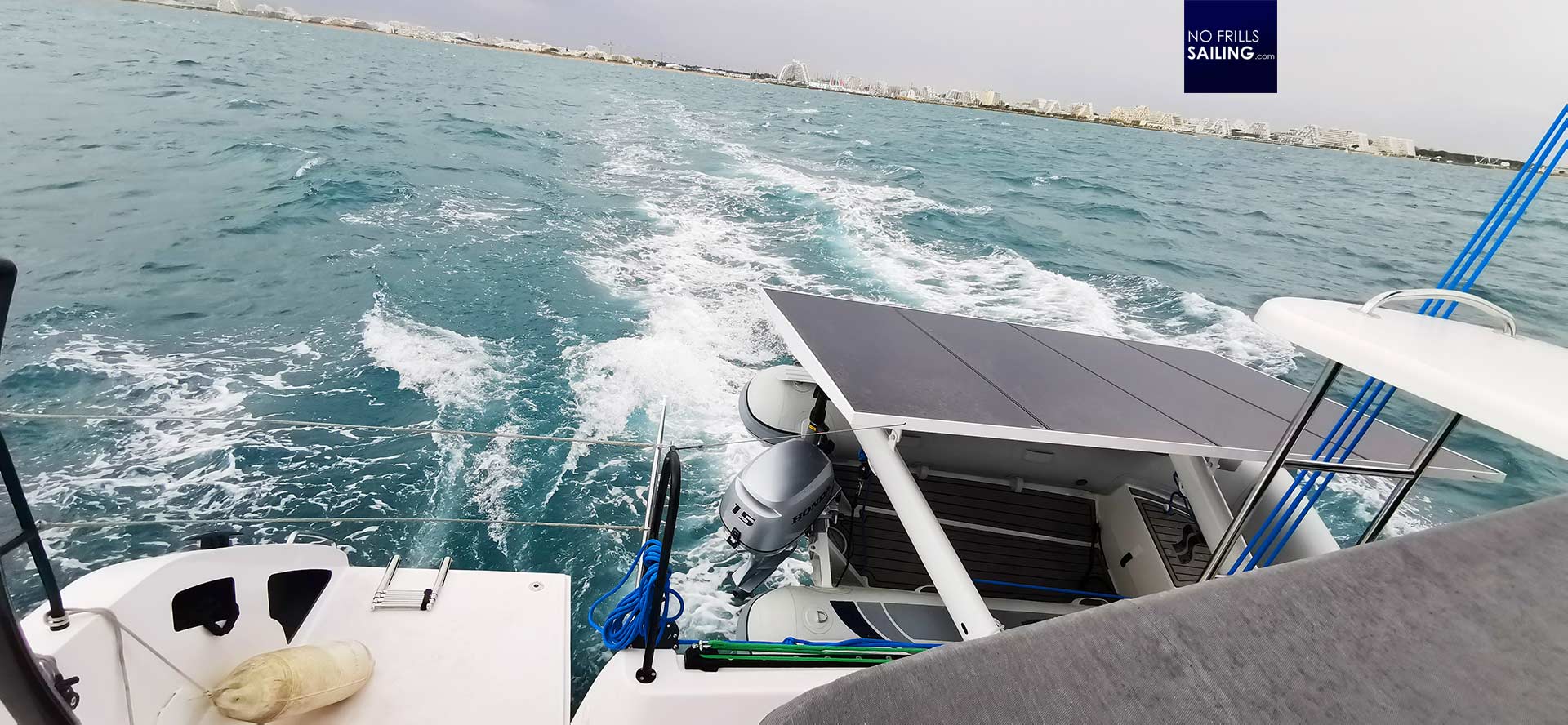
The guys tacked their way upwind which just for short periods of time almost stopped the cat only to let it pick up speed when the sails catched new wind on the opposite side. I went aft in the cockpit and listened to the “Swoooosh” of the two thin hulls sliding through the water: No vortexes at her stern, just two clean nice wakes.
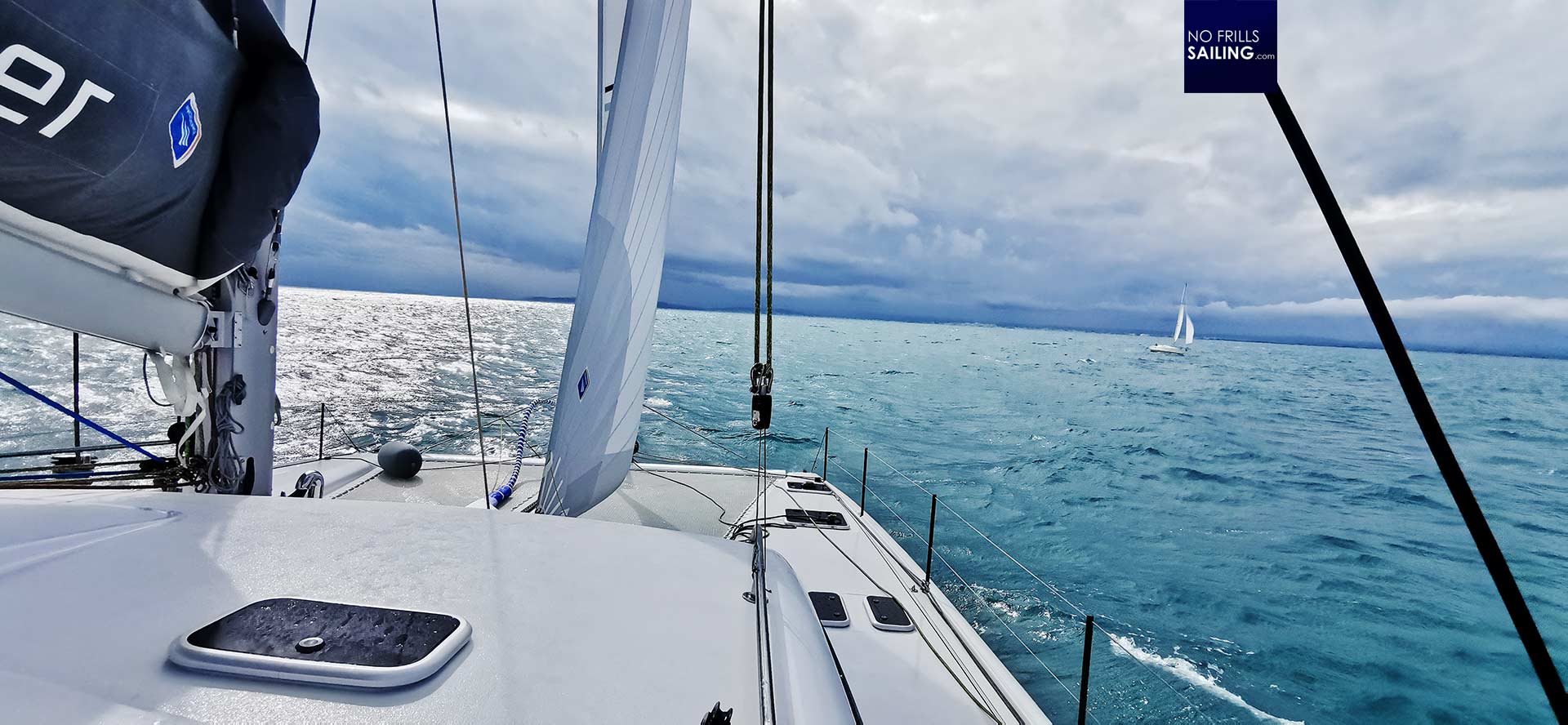
Apparently, we weren´t the only boat outside: Three crazy kite-foilers rounded out cataraman for a while, waved and disappeared. We met two monohulls on a reaching course, partially reefed and tumbling in the seas. The one big-time advantage, sailing comforts-wise, of a catamaran that could not have been demonstrated clearer: Whereas we could stand upright and had no heeling whatsoever, just coping with the motion of the cat within the waves a bit, our monohull-sailors over there in the boat surely could not move around on their boat without grabbing firm hold on their violently swinging boat. Let alone the speed and the sailing sensations.
The interior of the Outremer 45
As tacking upwind became a bit boring, I used the time to make an excursion into the Outremer 45´s internals. As I mentioned before, the boat is made for sailing and as such her dimensions and more so the internal volume are comparably narrow. The saloon, albeit being on a 45-footer, reminded me more of the Excess 11 saloon. A big U-shaped settee around the main table where our freezing passengers gathered.
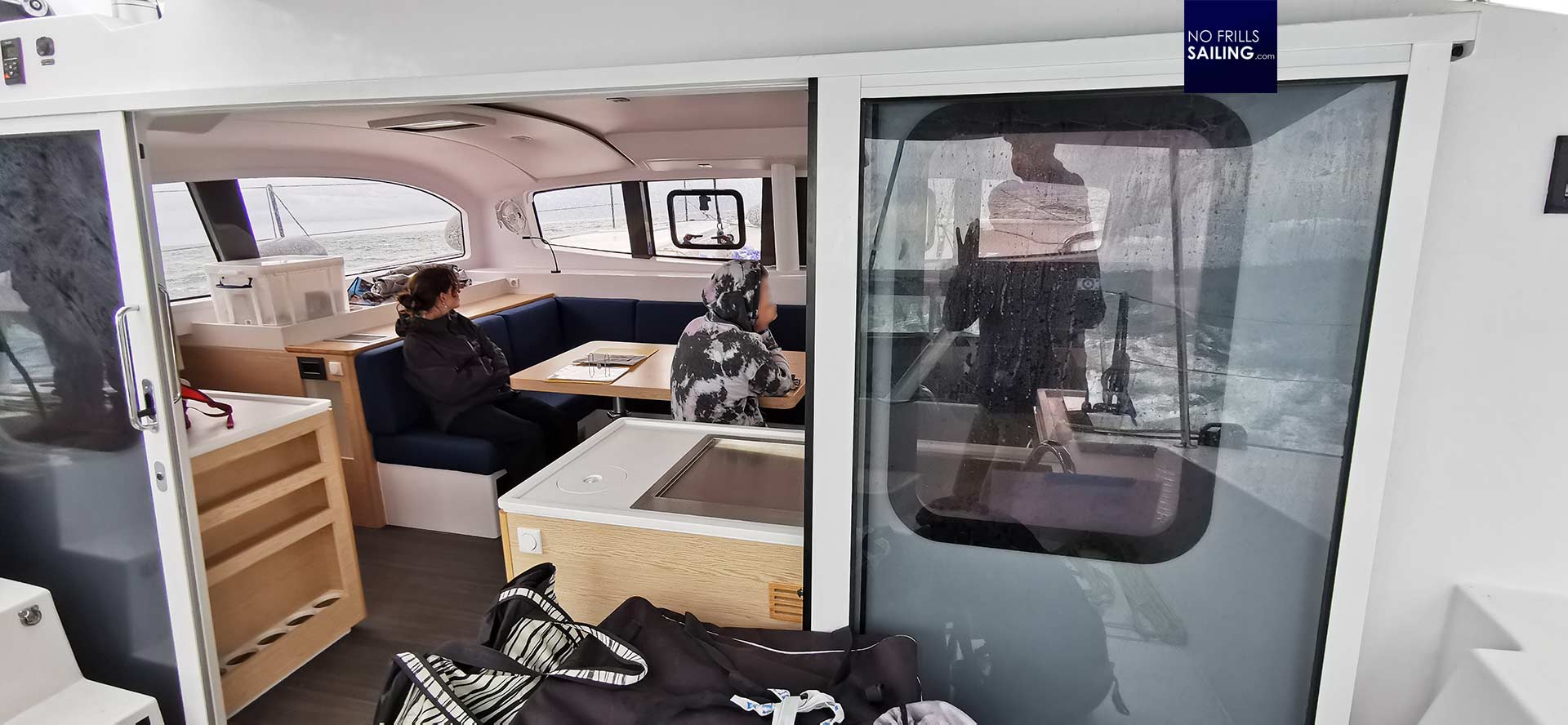
Everything inside is rather functional. I don´t want to call this “cold” but the design is clearly not done to achieve a comfy atmosphere. You may compare the interior of the Outremer 45 to a Pogo or similar performance-oriented brands: Functional, clean, clear but not appealing or rather pretty. On the other hand, owners of such a boat have much more freedom to add their personal style, color and material.
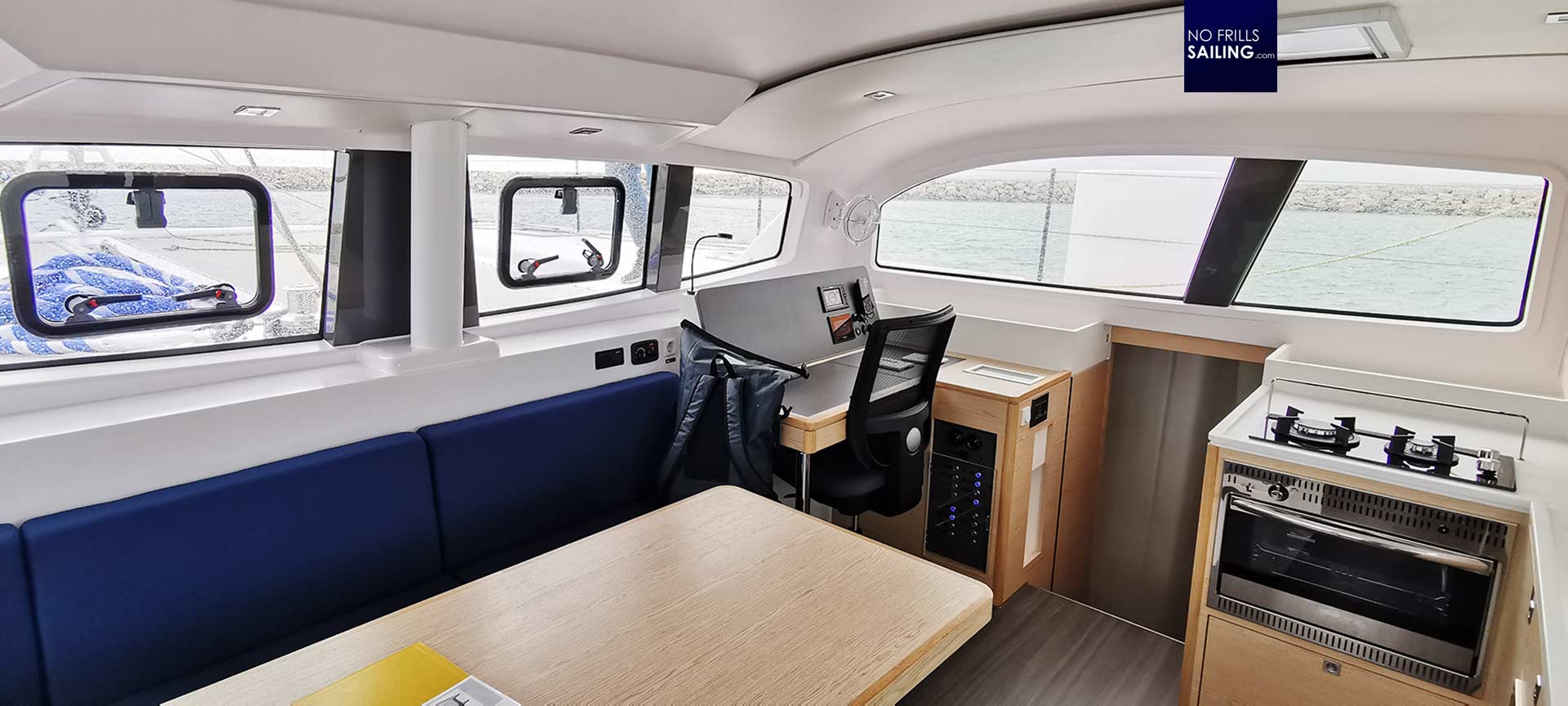
To starboard side right at the front windows a proper navigation station is positioned. I especially loved the swing stool which is a clear plus and the size of the chart table. Main switch panel and electric/electronic controls are situated here and the front board has more than enough space to have a secondary chart plotter and sister-displays installed.
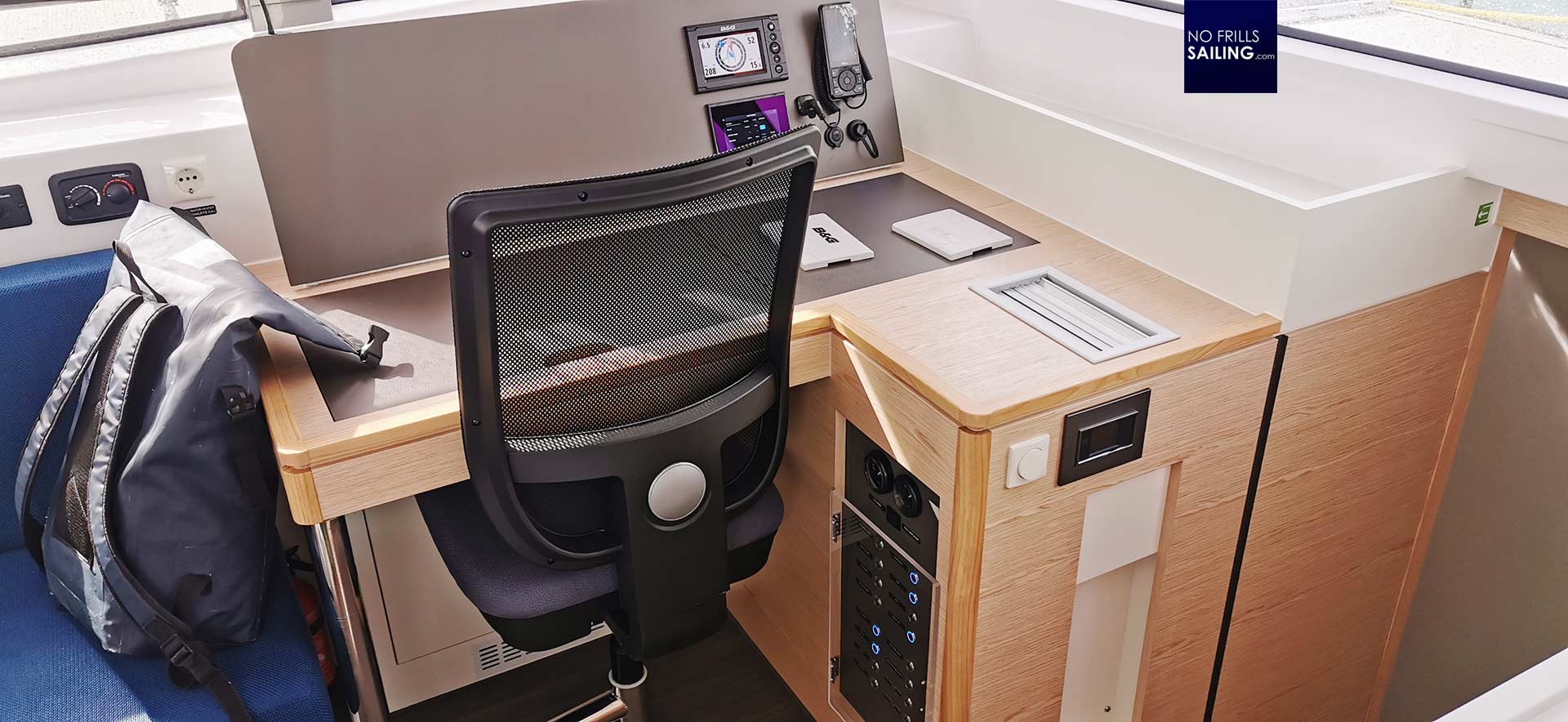
As this catamaran is made for long haul cruising the skipper clearly needs a working place like this as chartwork, logbook entries and paperwork in general must be done plenty of. It´s not like on the dedicated vocational boats for occasional cruising where the chart table is just a reminder of itself and a mere nod to seamanship.
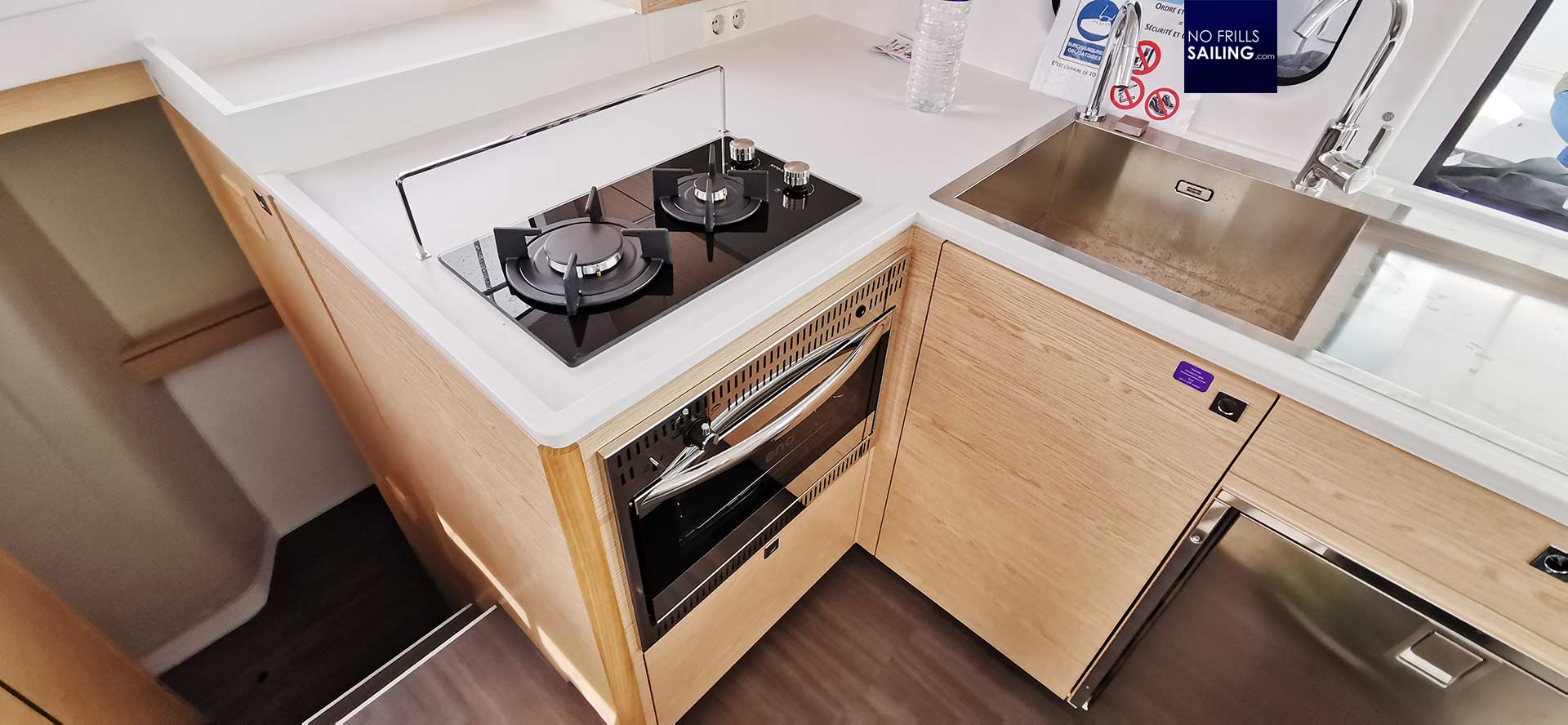
The galley is also rather small for a 45-footer, I´d say. Compared to the Excess 14 for example a ship´s cook does not have significant stowage or working space. It is more than enough for providing for meals, but I guess this is something Outremer salesmen will have to talk about a lot in their negotiations with potential buyers. Nevertheless, furniture quality of finishing wasn´t that much apart from big production boat quality, I especially like the big sink and the stove.
Down below decks: Cruising comforts of the Outremer 45
Let´s inspect the quarters and living conditions below decks. The Outremer 45 is available in two layouts. The “owner´s-version” with a dedicated hull to starboard just for the owner. One big berth in the stern, big bathroom and shower to the bow. This catamaran however was the 4-cabin-version with one bathroom per hull.
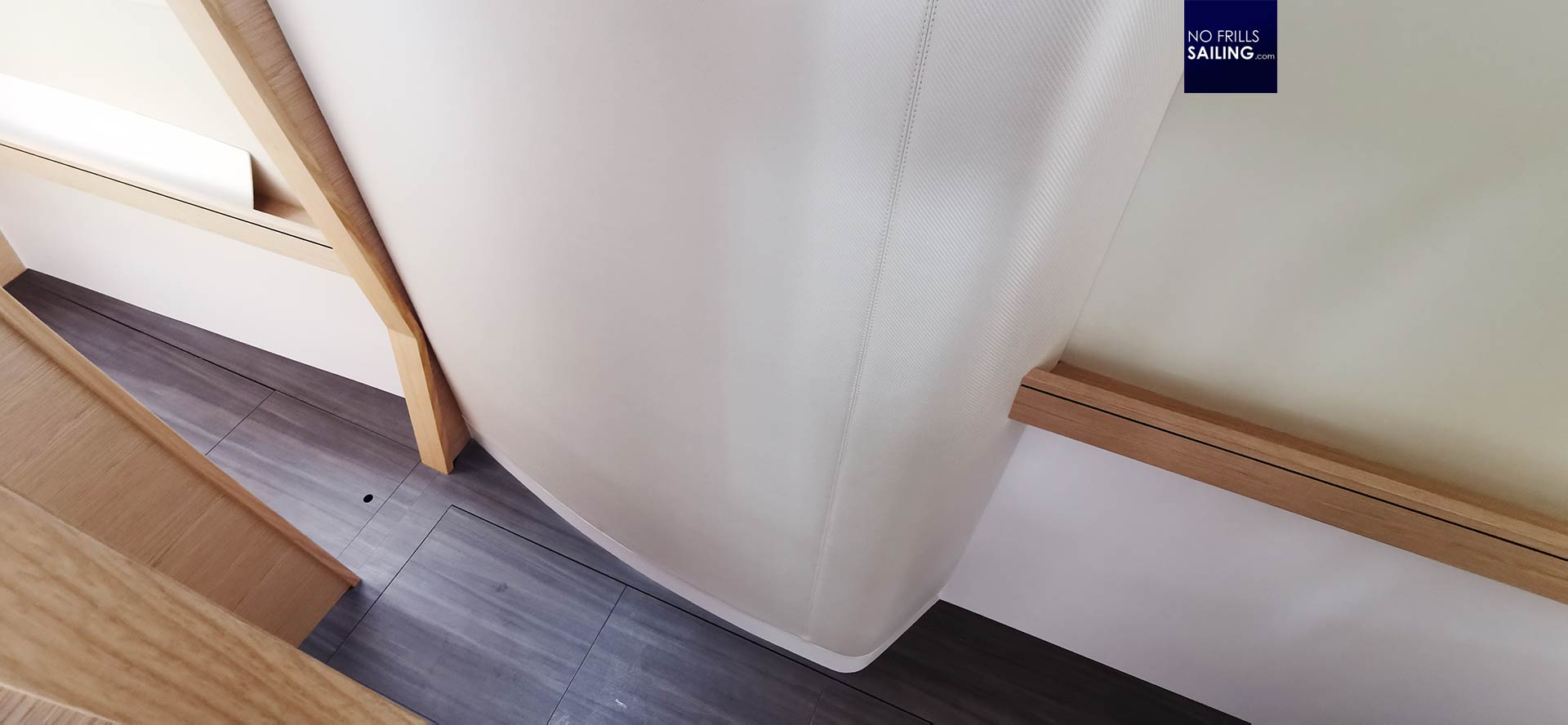
First thing you notice going down the ladders into the hulls are the big bulky daggerboard housings. I was surprised, at first, that there wasn´t any noticeable sound either from the water nor from the daggerboards which I somehow in my imagination thought would rumble around within the husings. That´s a plus.
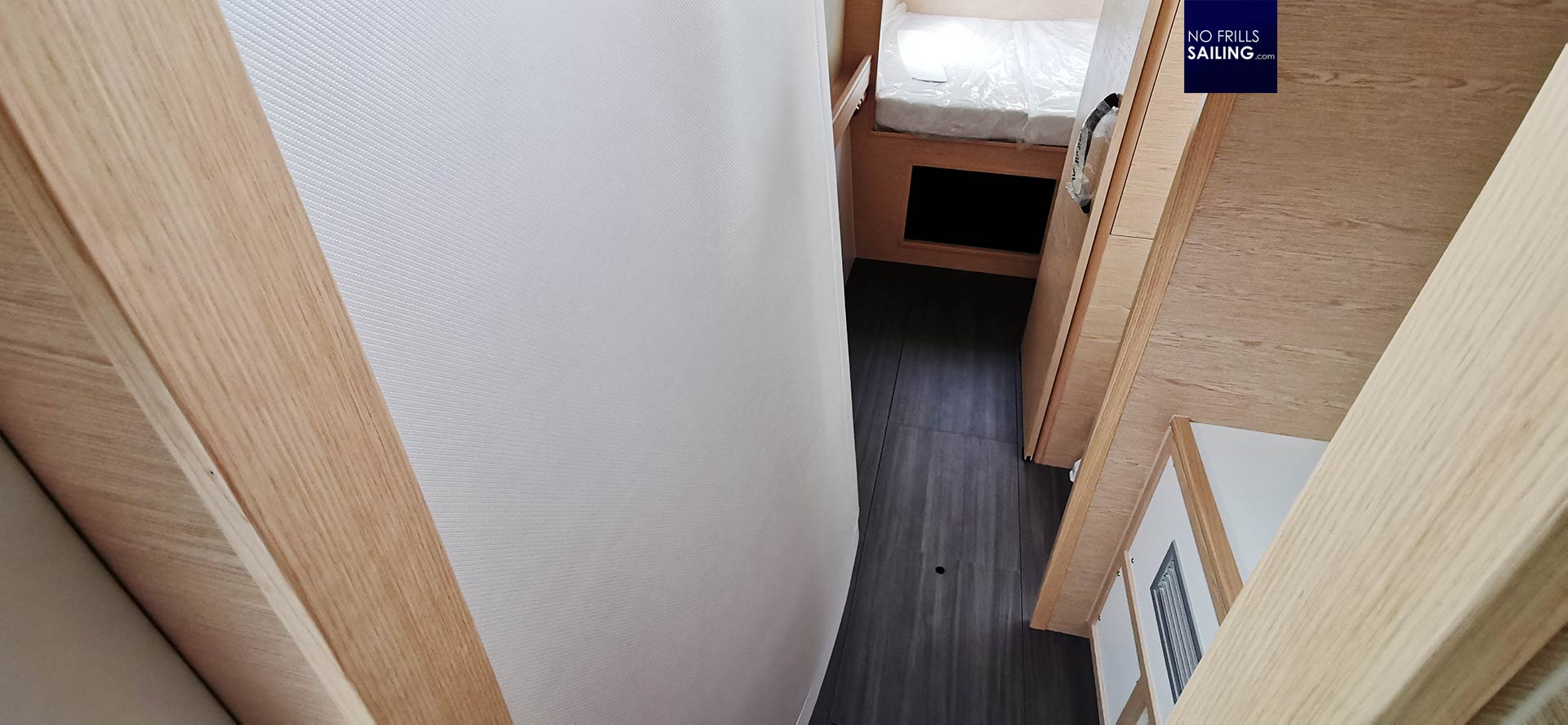
Also, the daggerboard housings are covered with a thick, soft damping material so that even in heavy seas one won´t be injured or bruised when slammed against them. Nevertheless, having such narrow (speedy) hulls with less lateral area as possible, the daggerboard housing take away much interior volume. The pathway passing these is narrow, also taking away space for lockers or a desk/workplace as seen in many other catamarans.
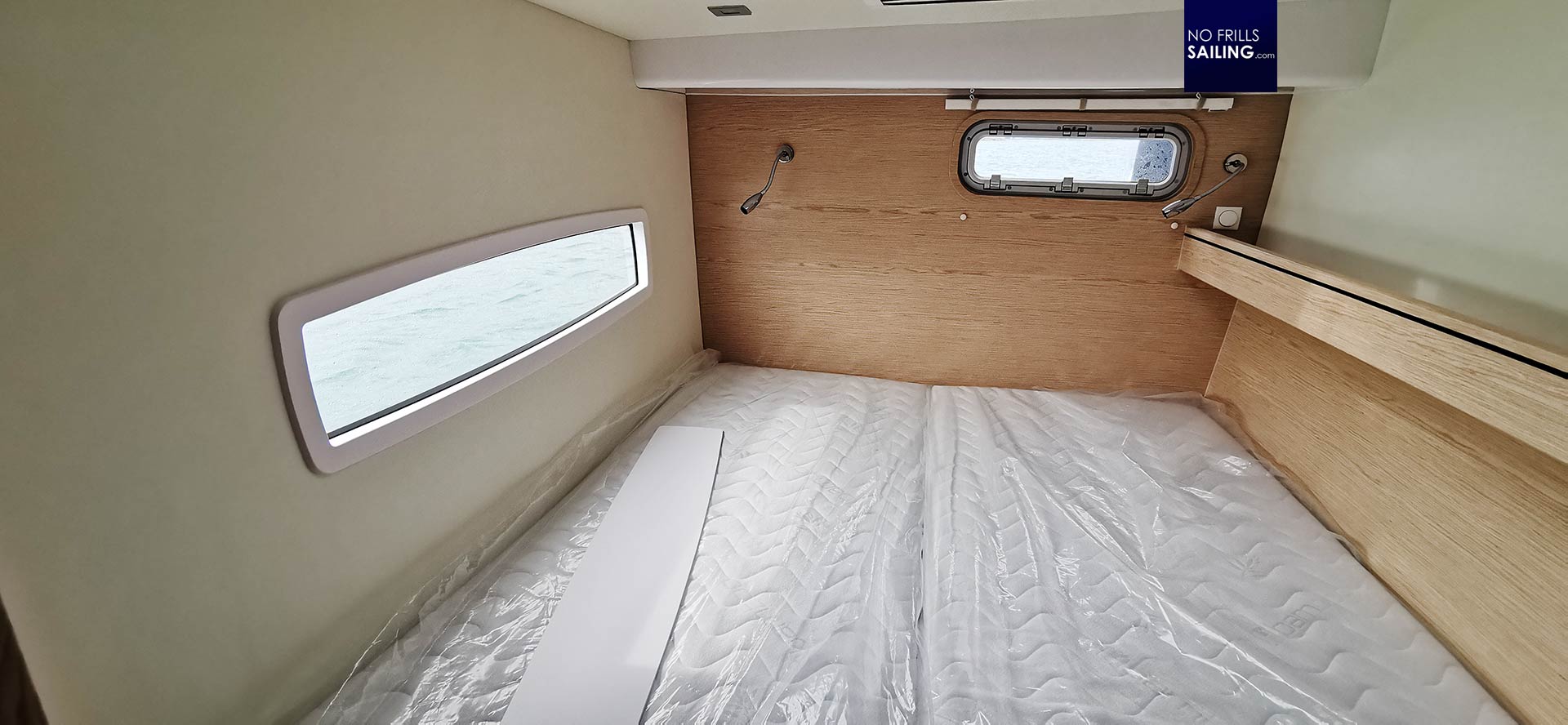
The beds are not the biggest either. Two persons will have sufficient space here, no questions, but compared to the bed size of the Excess 11, a much, much smaller 38-feet catamaran, these beds are very slim. Kudos to Outremer: The cabins were light-suffused as they are fitted with two windows and one big skylight hatch.
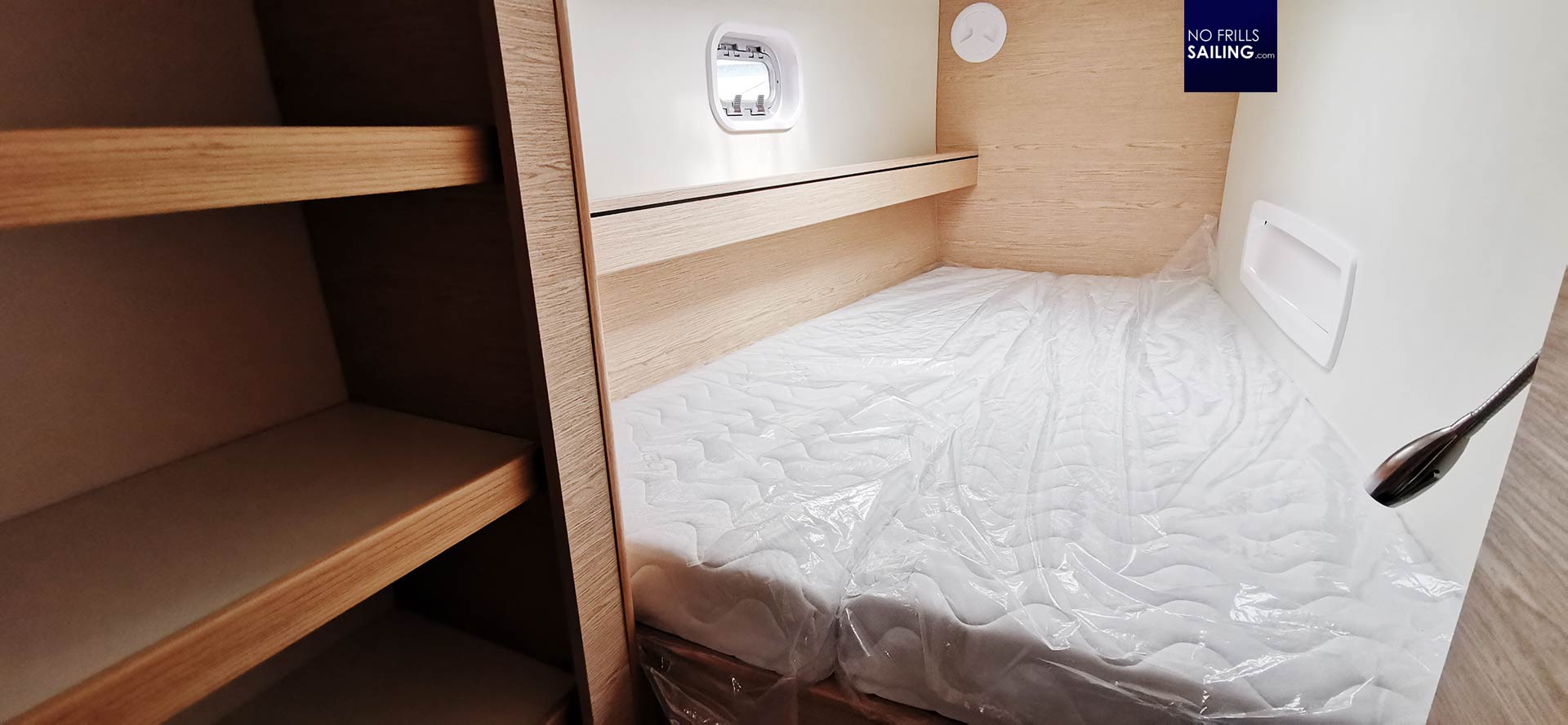
Same goes for the fore cabins. Beds are even slimmer as the hulls at this position are almost as thin as arrows, but I reckoned on the other hand that in heavy seas or when the boat has big time sea motion you anyway prefer to snug into some corner and wedge in between the walls. So, a disadvantage turned into an advantage. I otherwise would say that if occupied by just one person, the cabin sizes are absolutely okay. When sailing in warm regions most will anyway prefer to sleep on deck …
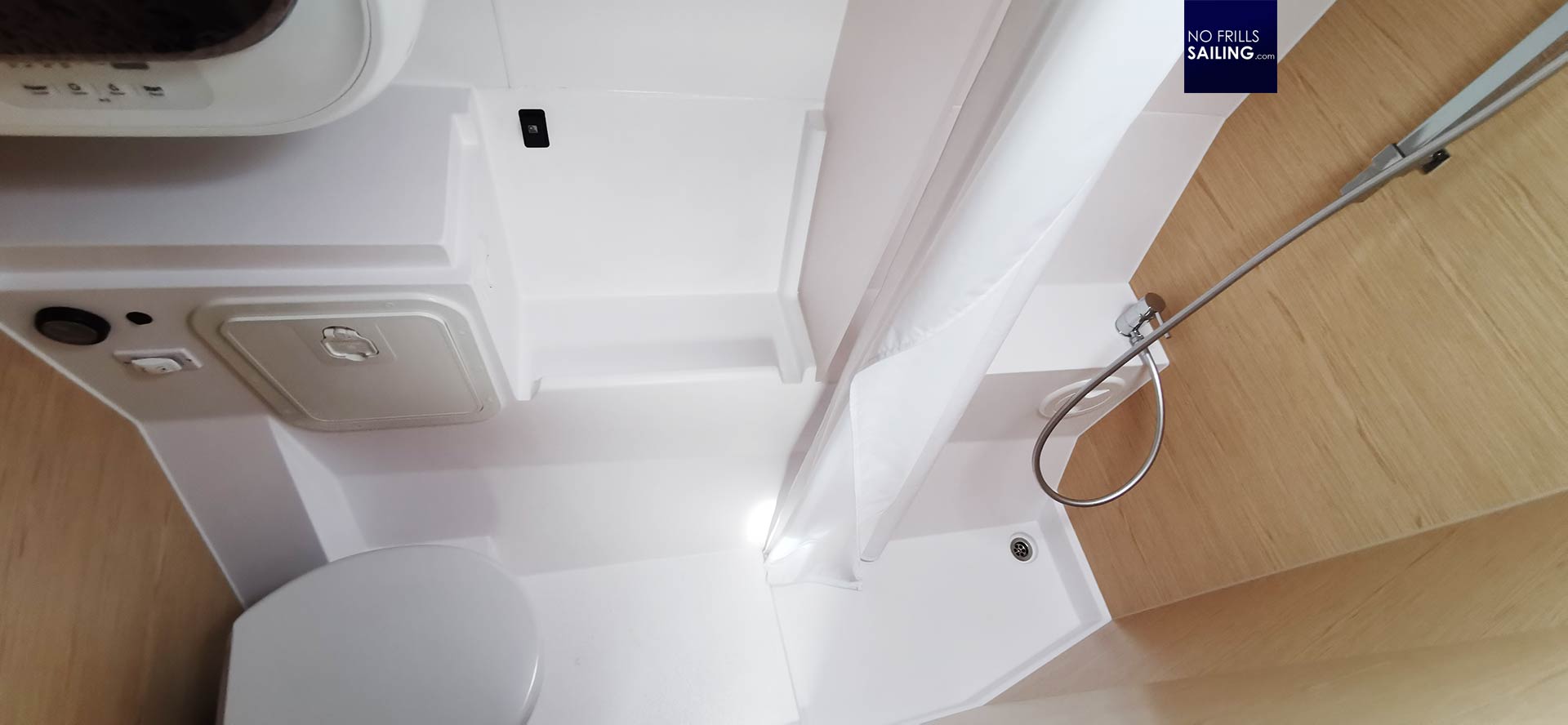
The bathrooms are of a decent size, given we sailed in rocky seas I though as well that a narrower space is a safer space as there is no room to fall and always a wall or a handle near to grab for a safe hold. The Outremer 45 4-cabin version has a much smaller owner´s bathroom than the 3-cabin version of course.

I really loved the kind of integration of the washing machine in the Outremer 45. This is a huge thing in cruising and serious long haul cruising: Getting your clothing clean and dry. Outremer apparently provides a solution here with this little machine that has been integrated very well and is a definitive plus for this cat. I wish we´d had a solution like this to offer.
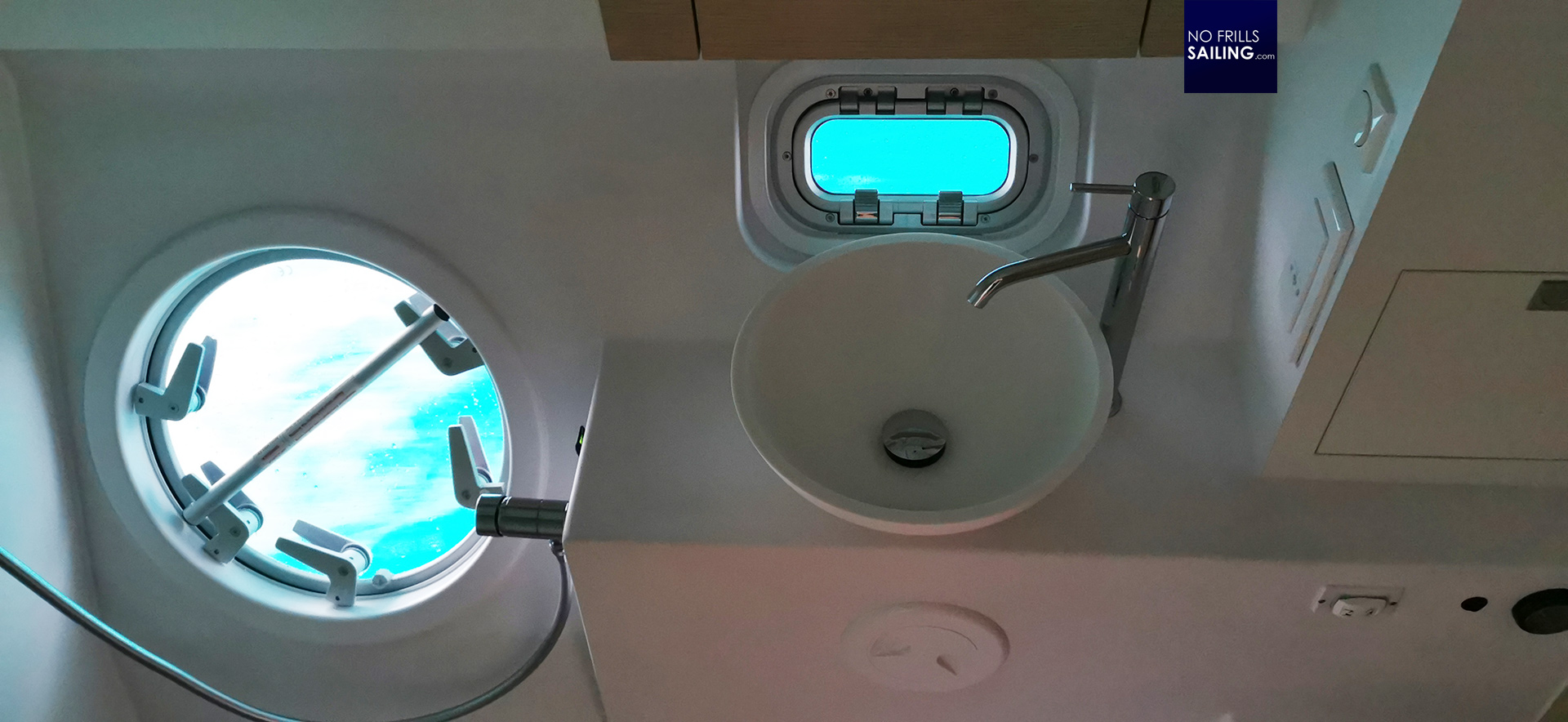
The guest bathroom in the port side hull was even more attractive as it features two windows, one of them being the emergency exit in case of a capsize, but the light of the blue ocean playing around in this room was awesome, creating a great atmosphere. Also, this bathroom is positioned much more to the pivot of the boat itself so less influence of sea motion: The better toilet when sailing.
At last: Downwind racing with kite up!
After one hour of tacking our way from the shore of the French Camargue we´ve had made enough leeway and distance to the marina. Our Captain ordered to bring about the boat to a downwind course. Opening the traveler and the mainsheet after shaking out the reef to full mainsail, we took in the jib by a short foot-pressing the electric winch.
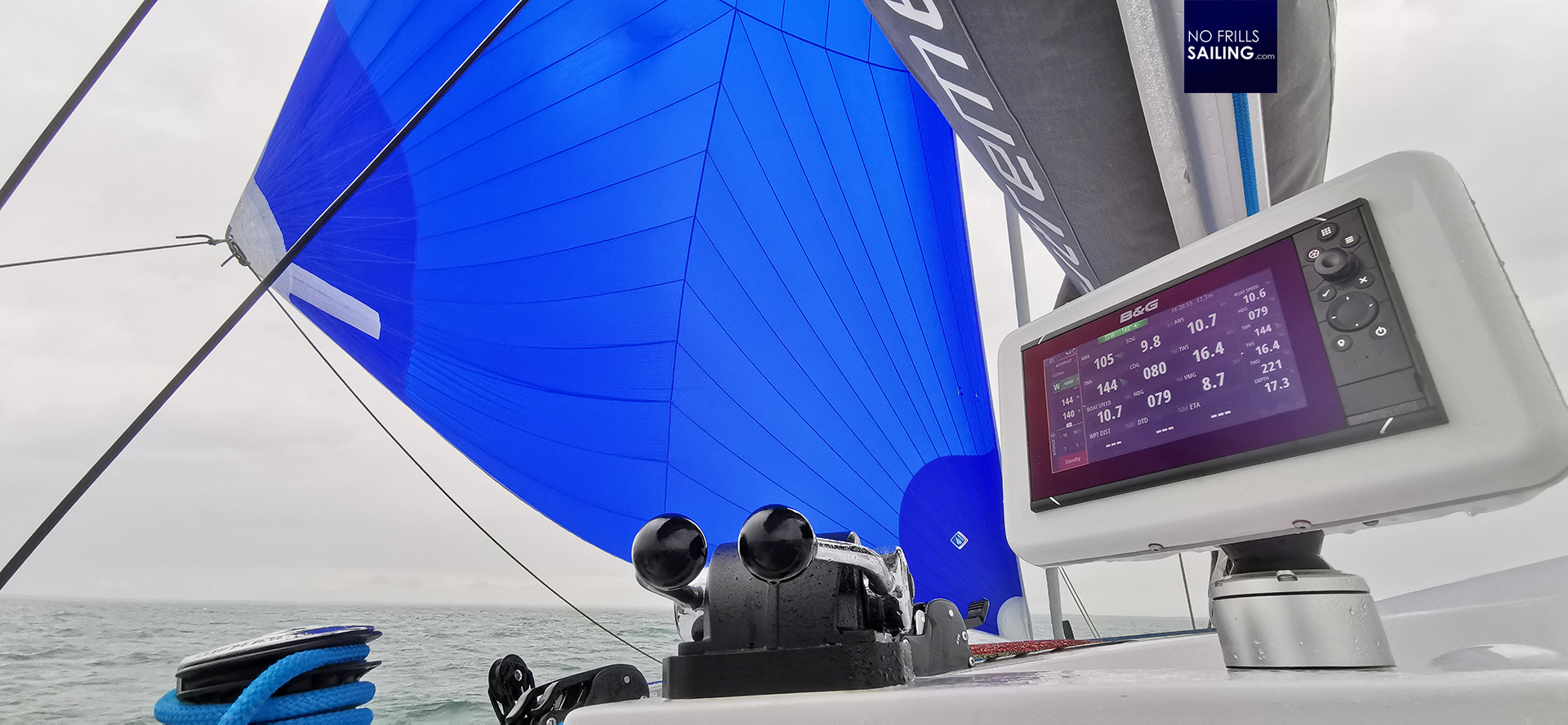
Our Outremer 45 featured a furling Gennaker. We were all keen on experiencing the downwind race in the Outremer. Catamarans are not made to sail upwind and will unfold their full potential on reaching courses. With a big smile on our faces we were excited when we´ve heard the word “… downwind …” against the backdrop of the swirling ocean and the gusty wind.
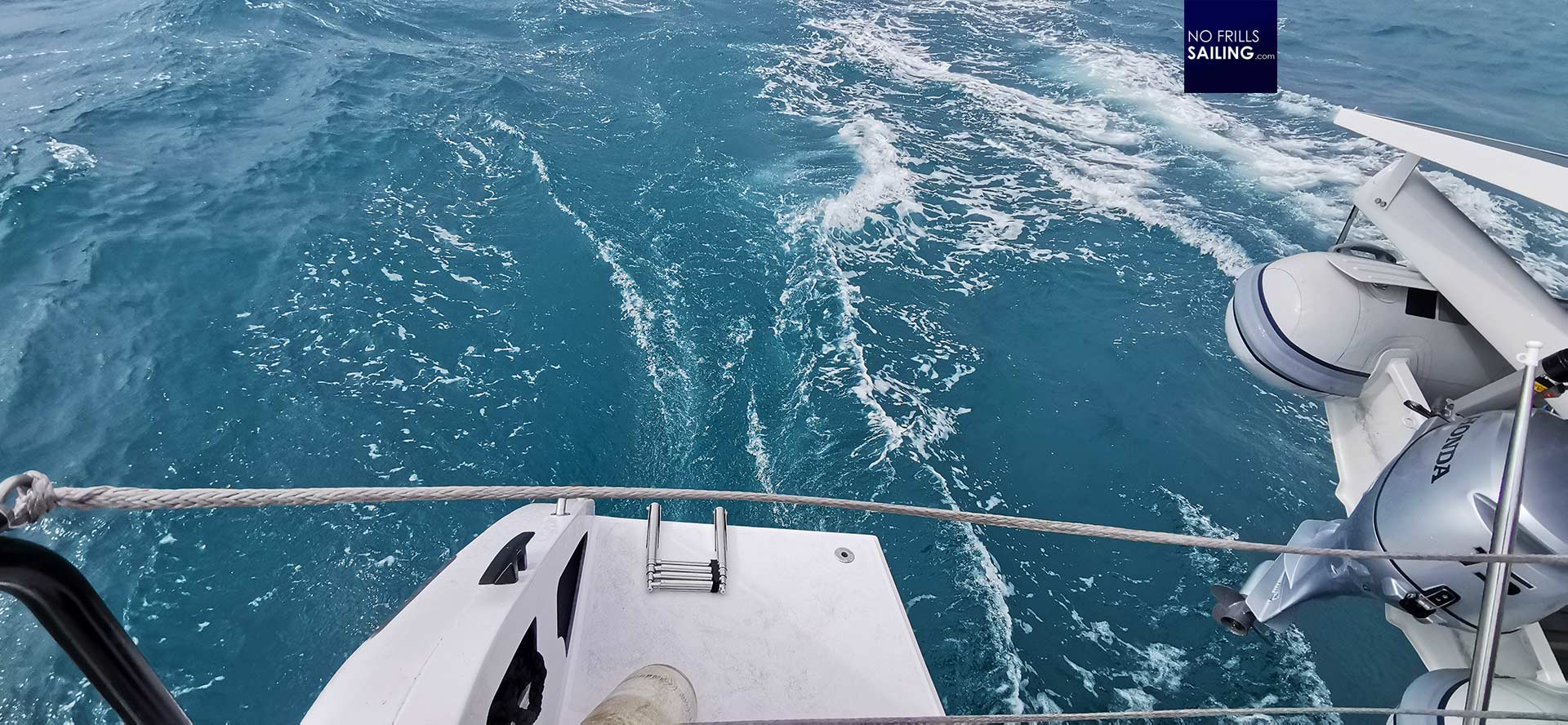
Unfurling the Gennaker took us under a minute and just like that the catamaran accelerated to full speed. The wind had eased a bit to 16-18 knots true. Nevertheless, the cat managed to sail at 11 to 12 knots average, in spikes we hit the 14. The Gennaker this boat carried was an A2, so a bit smaller and made of stronger material so that it may be used in stronger winds. I guess with a classy A3 Gennaker we could have added a knot or 2.
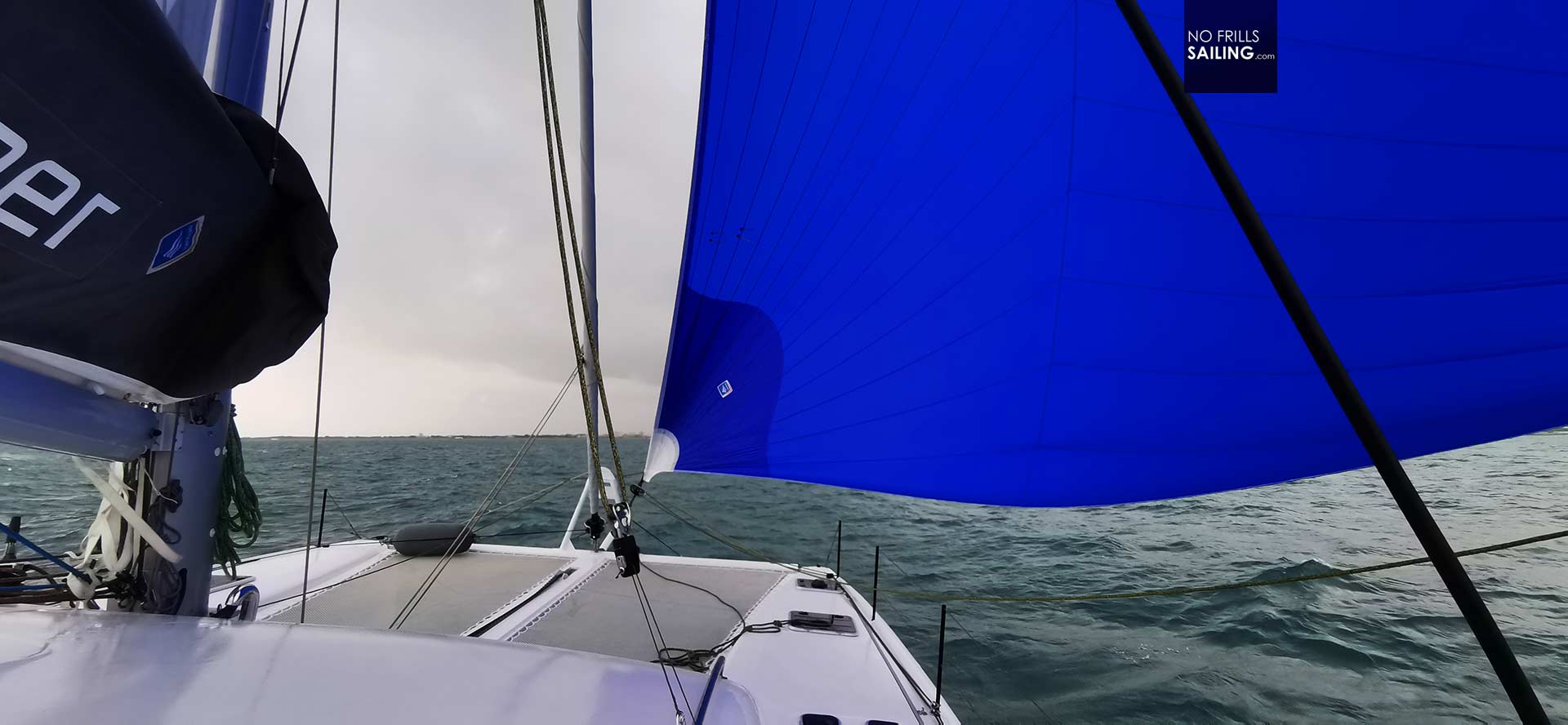
As I would consider myself more of a socket-type Gennaker fan, I was especially interested in the handling qualities of the furling Gennaker aboard. Of course, or crew of two consisted of professional Outremer skippers and as such their handling was flawless, but as I´ve heard a lot negative things about sandclocks and handling problems with furling Gennakers, I looked twice here. But even gybing wasn´t a problem, as it seemed, the furling-style worked flawlessly.
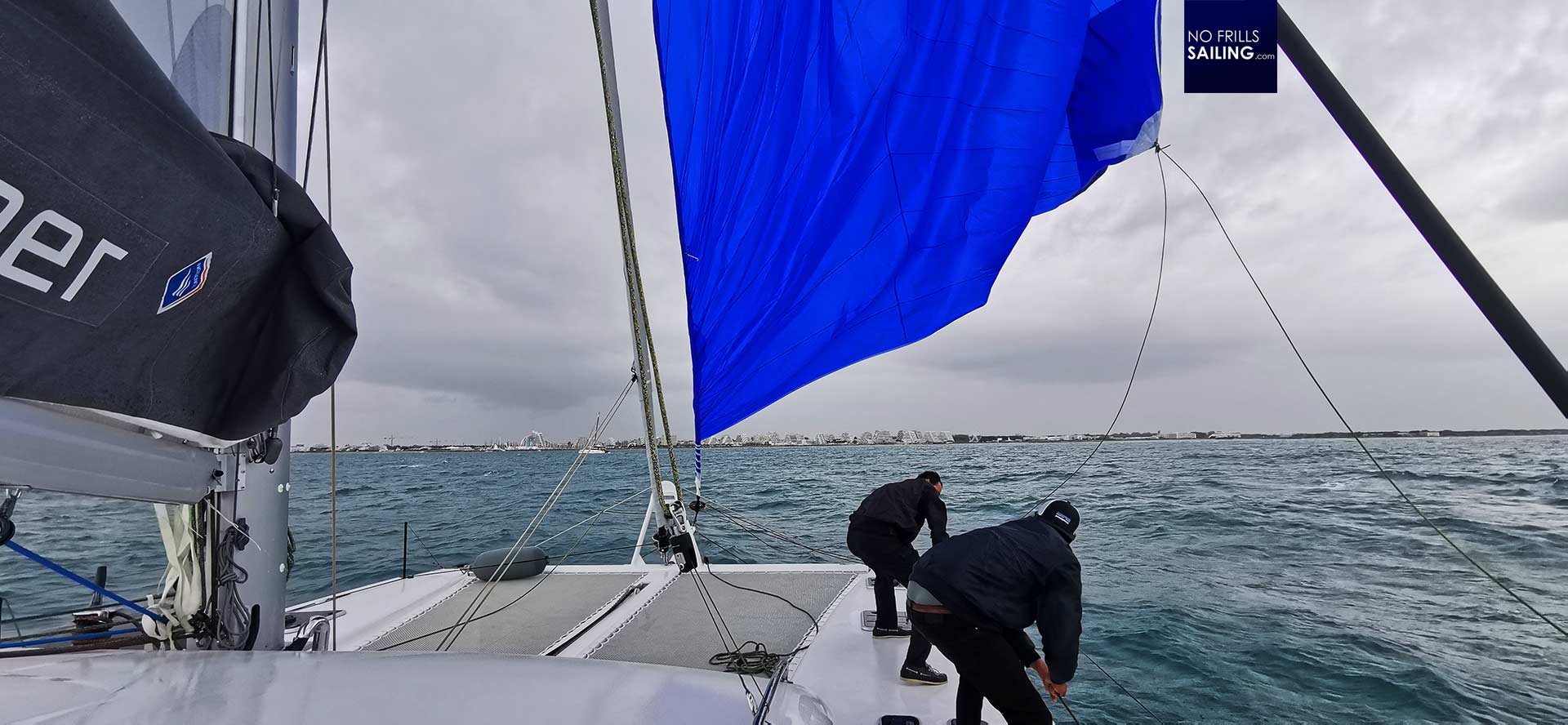
What took us winning about one hour of upwind tacking was eaten away by downwind flying in roughly twenty minutes. The catamaran flew before the wind, sometimes doing some bigger wiggly lines. I guess this is a matter of programming the autopilot to a more speedy and determined intervention when veering off course, though steering those sinuous lines on a running course in waves from behind is a matter of course.
My overall assessment of the Outremer 45
Again, masterfully handling the throttles, our Captain brought the cat back to pierside in a jaw dropping display of skillful steering qualities. After having tied up the cat at the pontoon, we shook hands and I thanked for this exceptional sea trial. What have I learned?
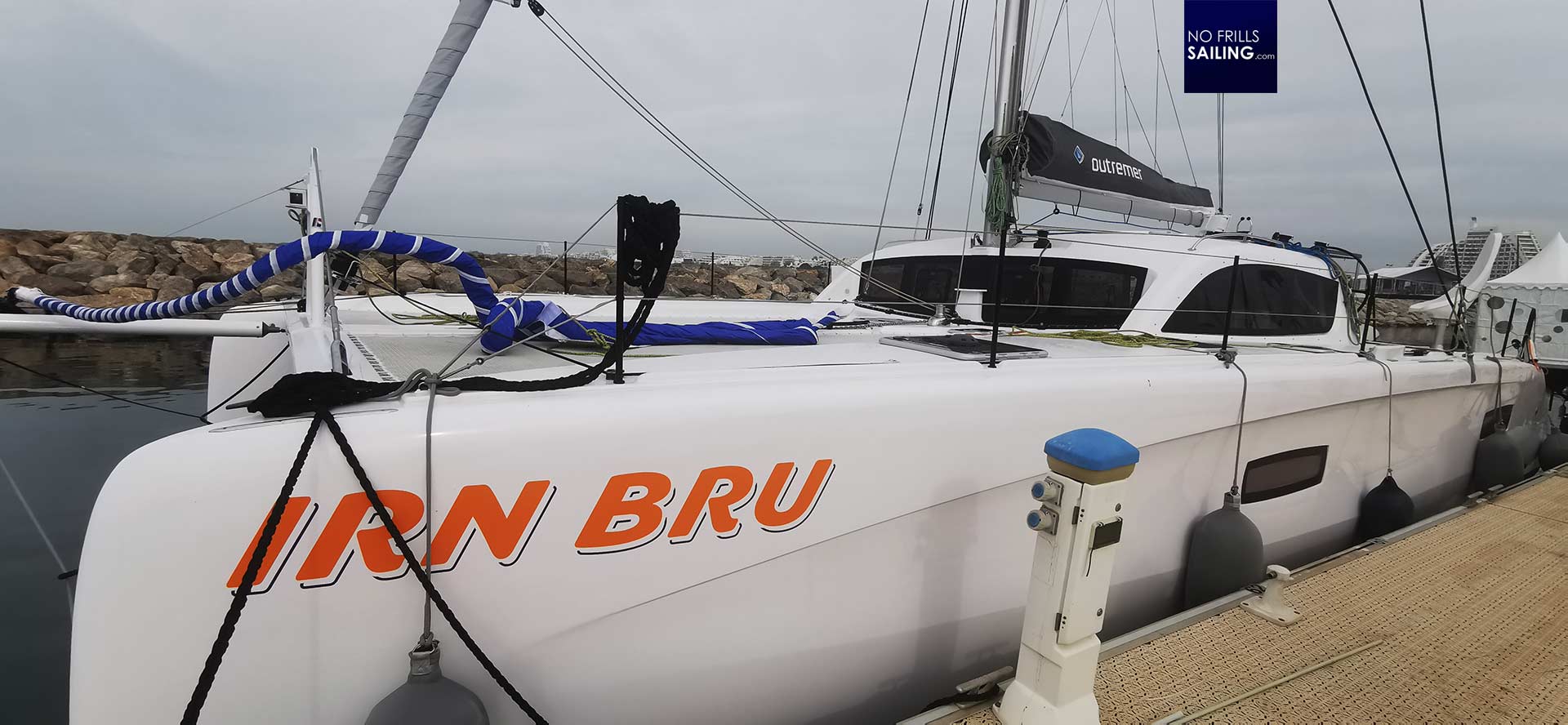
First of all, the Outremer 45 indeed is a thorough, seaworthy and surprisingly stable fast performance catamaran. She is made for serious sailors who are interested in active sailing, trimming and working the lines. She is a mile-eating boat, fast and superior to most of the boats around her. I haven´t heard any noises, squeaking or screeching. No slamming, wobble or noise announcing material problems. The structural finish is awesome – furniture quality is a bit less than expected.
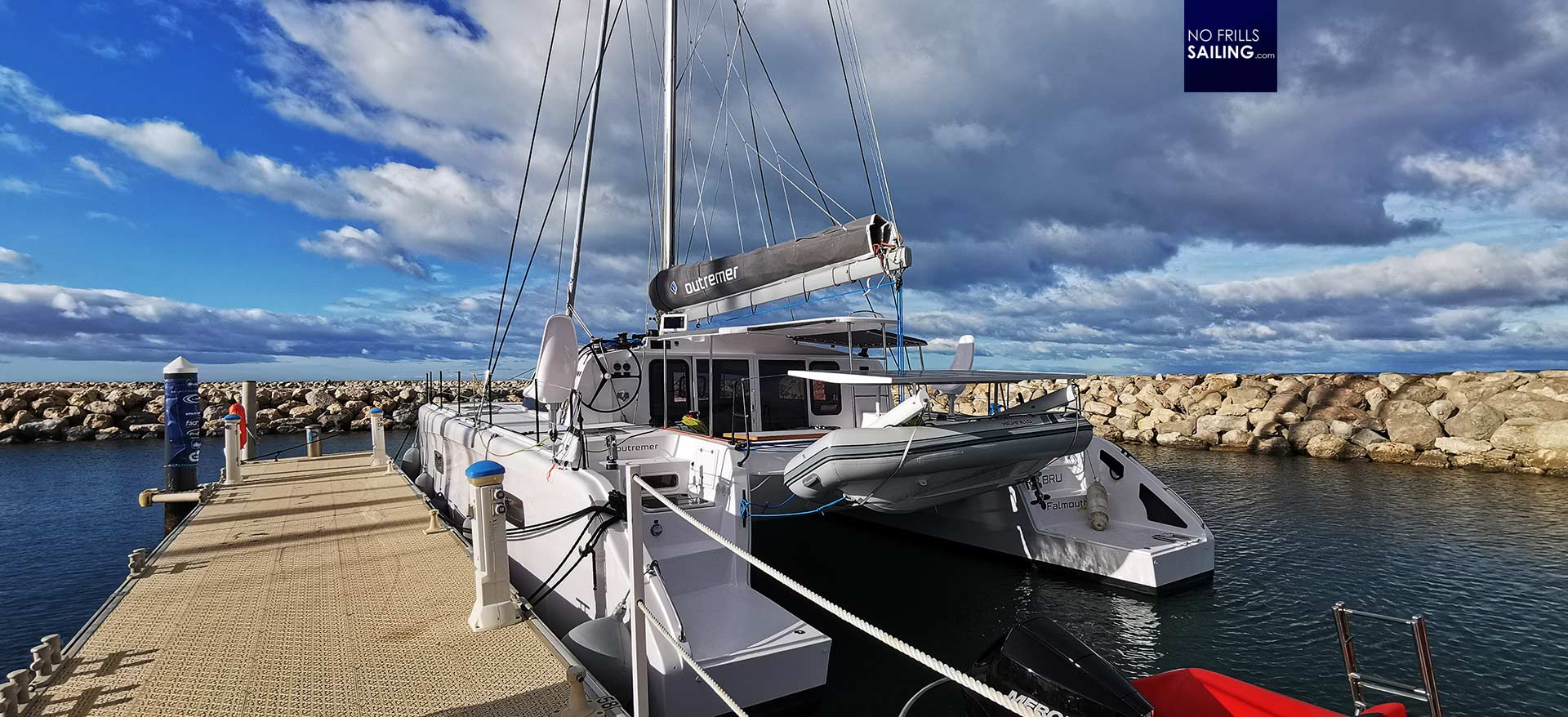
For a cruising family seeking a great vacation or a sabbatical, I´d say she offers less comforts. But this is always the big question: As comfort sacrifices performance, which of both do you seek? Which of both you´d like to be dominant? If you (and your crew!) are a big-time sailor seeking speedy offshore sensations, I am sure that the Outremer 45 will remain to be an absolute dreamyacht for ambitious skippers and she will go on being a best-seller.
Thanks so much, Outremer, for providing this exceptional experience, especially under these conditions.
You might as well be interested in these articles:
Catamaran boost: My first catamaran delivery sailing trip
Biscay Trap – too much wind for our Excess?
44 feet catamaran that will boost sailing sensations.
